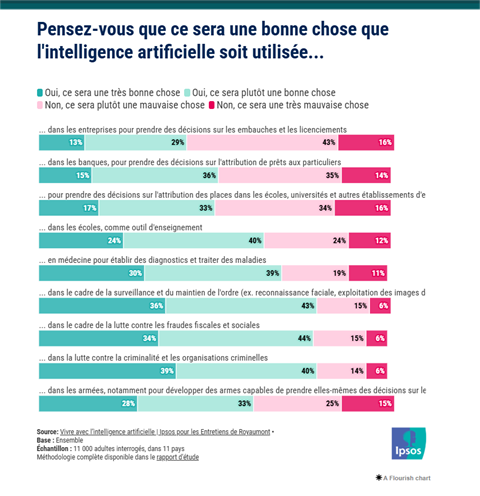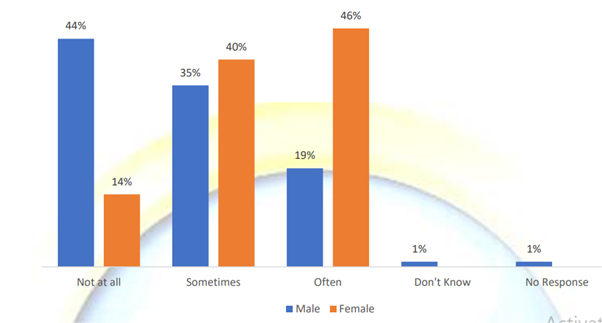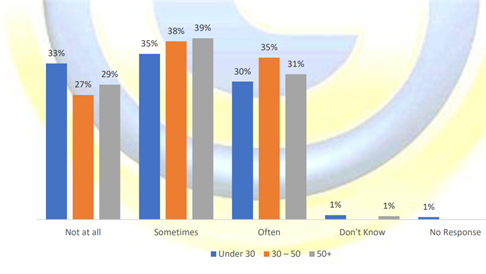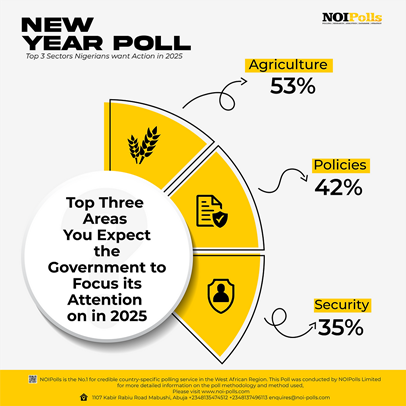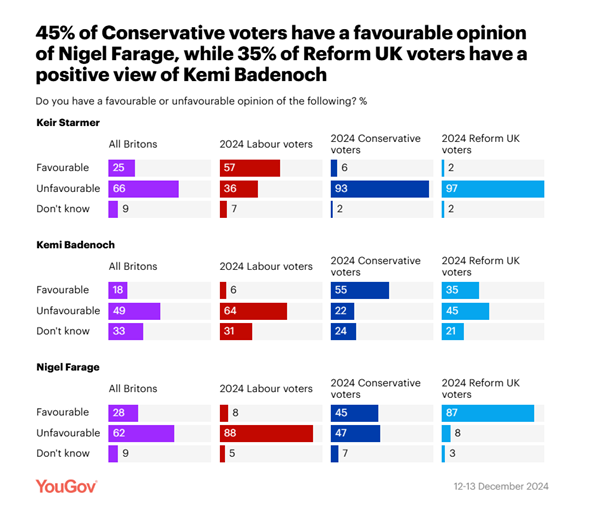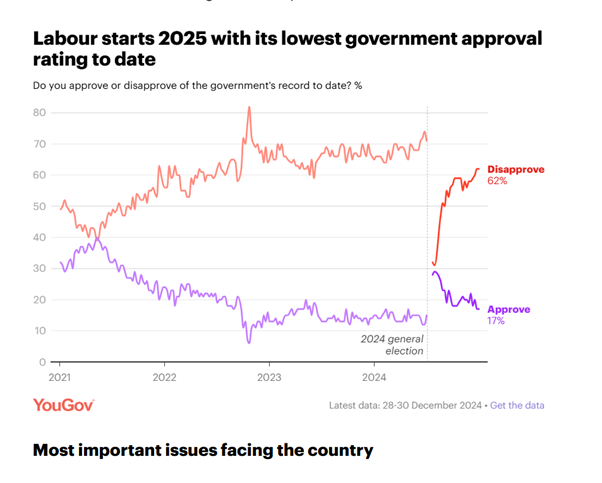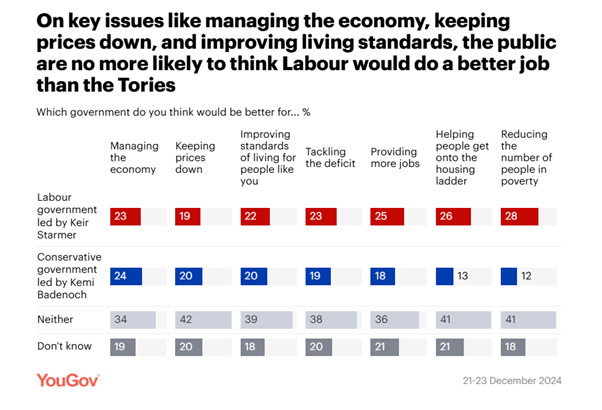|
BUSINESS & POLITICS IN THE WORLD GLOBAL OPINION REPORT NO. 880-881 Week:
December 30, 2024 - January 12, 2025 Presentation:
January 24, 2025 As South Korea’s
Impeached President Yoon Awaits Fate, His Party Sees Signs Of Revival 2 How The Gaza War Is
Shaping MENA Public’s Support For The Two-State Solution 5 Nigerians Want
Government To Prioritize Agriculture, Economic Policies And Security 10 Where Public Opinion
Stands At The Beginning Of 2025 14 What Worries The World
– December 2024 20 Living With Artificial
Intelligence: Opportunity Or Threat? 26 Half Of The Spanish
Population Is Dissatisfied With Its Democratic System 30 Bank & Insurance
Brand Mover December 2024 31 Worry About Violent
Crime, Wanting To Have A Gun, If The Police Come 34 Tipping Points In The
Climate Transition: Is The Netherlands Ready For The Acceleration? 41 Americans Think
History Will Rate Biden Presidency Negatively 42 What The Data Says
About Federal Workers 47 Will Canada Move
Beyond Disruption In 2025? 57 7 Out Of 10 Brazilians
Believe That 2025 Will Be A Better Year 58 ALP Support Down,
Consumer Confidence & Inflation Expectations 60 Economic Inequality
Seen As Major Challenge Around The World 63 INTRODUCTORY NOTE This weekly
report consists of nineteen surveys. The report includes one multi-country
studies from different states across the globe. 880-881-43-20/Commentary:
Living With Artificial Intelligence: Opportunity Or Threat? In order to
better understand the perception of artificial intelligence (AI) around the
world, Ipsos conducted a major survey in 11 countries for the 21st edition of
the Royaumont Interviews. The results highlight a mix of enthusiasm and fear
regarding this technology, with more marked concern in France. Overall,
emerging countries appear, as is often the case with technology, more
enthusiastic than advanced economies. But everywhere, there is a consensus on
the need to regulate AI. As for the uses of AI, they are popular in medicine
and education – but contested in terms of hiring/firing, granting loans or
allocating places in educational establishments. As much enthusiasm as concern
about AI This is the first
observation of this study: if two-thirds of respondents (66%) believe that AI
will bring opportunities and solutions, half (50%) say they are afraid of
it.
Concern is high
everywhere – but particularly in France, where three-quarters of respondents
say they fear the impact AI will have on the world they live in. Only the
Japanese and Chinese say they are mostly confident. Everywhere, fears are
more about the consequences on the world than on the personal lives of those
surveyed.
Emerging countries are more
positive about AI As is often the case with technology issues, emerging
economies are more confident: the share of people saying they are
enthusiastic about AI is significantly higher.
There is consensus on the need
to regulate AI Across the 11 countries surveyed, nearly 9 in 10 people say
they support regulating AI through legislation. Reasons include protecting
against aggressive business practices, safeguarding individual freedoms and
preserving privacy.
Popular uses and contested ones The use of AI in medicine (69% of people in favor) and in
education (64%) is widely approved. On the other hand, its use for hiring and
firing decisions (42%), allocation of places in educational establishments
(50%) or granting loans (51%) raises more reservations. The French are among
the most reluctant to see AI intervene in these areas. (Ipsos France) January 08, 2025 Source:https://www.ipsos.com/fr-fr/vivre-avec-lintelligence-artificielle-opportunite-ou-menace ASIA (South Korea) As South Korea’s Impeached
President Yoon Awaits Fate, His Party Sees Signs Of Revival Impeached South Korean President
Yoon Suk Yeol, under investigation for martial law and insurrection, faces public
division with 59% supporting his arrest. A failed arrest attempt has rallied
his supporters, boosting his party’s approval to 34.4% (Realmeter) compared
to the opposition's 45.2%. His fate lies with the Constitutional Court, while
conservatives, inspired by Trump-era rhetoric, are uniting to counter past
electoral losses and challenge the opposition's majority. (Asahi Shimbun) January
10, 2025 (Pakistan) Nearly 7 In 10 (69%) Pakistanis
Experience Headaches Either Often Or Sometimes, With Women (86%) And
Middle-Aged Individuals (73%) Significantly More Likely To Suffer A Gallup & Gilani Pakistan
survey reveals nearly 7 in 10 Pakistanis experience headaches either often
(32%) or sometimes (37%), with women (86%) and middle-aged individuals aged
30-50 (73%) most affected. In contrast, younger adults under 30 report the
lowest frequency (65%), while 29% of respondents overall claim they never
experience headaches. (Gallup Pakistan) January 01, 2025 AFRICA (Kenya) Majority Of Kenyans Believe
Country Is Headed In The Wrong Direction, Cite Government’s Poor Handling Of
The Economy Kenya’s economy grew by 5.6% in
2023, but 59% of citizens see the country heading in the wrong direction,
with 61% rating the economy as bad and 59% experiencing poverty in the past
year. Due to citing poverty, rising costs, and poor government management.
Many faced shortages of basics, sought help, and prioritized health,
unemployment, and living costs as key issues, though 57% remain hopeful for
improvement. (Afrobarometer) January
10, 2025 (Nigeria) Nigerians Want Government
To Prioritize Agriculture, Economic Policies And Security Nigerians want the government to prioritize
agriculture (53%), better economic policies (42%), and security (35%) in
2025, citing food inflation, economic challenges, and insecurity as key
issues. Other areas highlighted include reducing fuel prices (26%),
infrastructure (21%), electricity supply (20%), job creation (16%), and
healthcare (7%). With agriculture contributing significantly to GDP and
employment, and economic and security concerns affecting daily life,
addressing these priorities is crucial for socio-economic transformation in
Nigeria. (NOI
Polls) January 06,
2025 WEST EUROPE (UK) Where Public Opinion Stands At
The Beginning Of 2025 As 2025 begins, Britain faces
growing dissatisfaction with Labour’s government. PM Keir Starmer’s net
favourability has dropped to -41, with 66% of Britons holding a negative
view. Labour’s handling of the economy and inflation is widely criticized,
with approval among its own voters plummeting. Immigration concerns have
reached record highs, with 70% saying levels over the past decade are too
high. While Labour still leads on issues like housing and poverty, public
trust in their governance continues to erode, as discontent spreads across
political divides. (YouGov UK) January 02, 2025 (France) Living With Artificial
Intelligence: Opportunity Or Threat? A global survey shows mixed
feelings about AI, with 66% seeing it as an opportunity, but 50% expressing
fear, especially in France. Emerging economies are more optimistic, and there
is strong support (90%) for regulating AI. AI in medicine (69%) and education
(64%) is favored, while its use in hiring, loans, and education raises
concerns. Military AI is supported by two-thirds. (Ipsos France) January 08, 2025 (Italy) Bank & Insurance Brand
Mover December 2024 Buddybank emerged as the
top-performing brand in Italy's Bank & Insurance sector in December 2024,
showing significant growth in awareness, ad recall, and word-of-mouth
exposure, driven by Davis Cup sponsorship and active social media efforts.
The brand's overall health, measured by the BrandIndex, improved notably,
with its reputation metric more than doubling compared to November.
Additionally, both consideration for purchase and the customer base reached
their highest peaks in the last six months. (YouGov Italy) January 08, 2025 (Sweden) Worry About Violent Crime,
Wanting To Have A Gun, If The Police Come A recent survey in Sweden shows
rising insecurity, with 45% of people feeling less safe, especially women and
SD supporters. Crime, war, and violent crime are top concerns, leading to 21%
wanting firearms for self-defense. Despite high trust in police, 65% doubt
their ability to respond in time. This growing sense of self-reliance
highlights a divide in Swedish society, particularly between those focused on
local crime and global threats. (Novus) January 07, 2025 (Netherlands) Tipping Points In The Climate
Transition: Is The Netherlands Ready For The Acceleration? A recent study shows that nearly half of Dutch
citizens support faster CO2 reduction, with behavior often lagging behind
intentions. Key areas for change include energy, raw materials, food,
society, and wellbeing. Social tipping points can be triggered by just 25% of
the population, offering hope for faster sustainability if policies align
with public readiness. (Motivaction
Insights and Strategy) January
07, 2025 NORTH AMERICA (USA) Americans Think History Will
Rate Biden Presidency Negatively A Gallup poll shows that most
Americans expect Biden to be judged negatively, with 54% rating him as
"below average" or "poor." While Democrats are more
favorable, Republicans and independents are largely critical. Biden's ratings
resemble Nixon's, and he's the only recent Democratic president with a
net-negative evaluation among independents. However, past presidents have
seen their ratings improve over time, suggesting Biden's legacy may shift as
well. (Gallup) January 07, 2025 What The Data Says About
Federal Workers President-elect Trump aims to cut
federal spending and reduce the workforce by up to 75%, with Elon Musk and
Vivek Ramaswamy leading the effort. The federal government employs over 3
million people, including more than 600,000 in the U.S. Postal Service. The
Department of Veterans Affairs has the largest workforce, while the
Department of Education has the smallest. Federal workers are mostly
white-collar, older, and more likely to be Black compared to the general
workforce. Public opinion is divided on government size, with many favoring
smaller government and others supporting expanded services. (PEW) January 07, 2025 (Canada) Will Canada Move Beyond
Disruption In 2025? Ipsos' 2024 reflection highlights
that Canadians are focused on addressing current issues like affordability,
immigration, and climate change, with little optimism or aspiration. Public
opinion has influenced political and business actions, but the impact on
Canadians' well-being remains uncertain. Context plays a crucial role in
shaping reactions, as seen in responses to extreme weather and economic
measures. Overall, 2024 is seen as the first true post-pandemic year marked
by disruption and uncertainty. (Ipsos Canda) December
30, 2025 SOUTH AMERICA (Brazil) 7 Out Of 10 Brazilians Believe
That 2025 Will Be A Better Year Despite a challenging 2024, 79% of
Brazilians are optimistic about 2025, believing it will be a more promising
year. Confidence in the global economy and personal growth is high, with 82%
planning resolutions for the year. However, concerns about rising prices,
inflation, and interest rates persist, with 73% expecting prices to outpace
income growth. Health optimism is notable, with 81% expecting better physical
and 79% better mental health. Environmental concerns about climate change and
extreme weather are prevalent, while the impact of AI on jobs remains a point
of debate. The outlook for Brazil in 2025 is a mix of hope and challenges. (Ipsos Brazil) December 06, 2024 AUSTRALIA (Australia) ALP Support Down, Consumer
Confidence & Inflation Expectations In early 2025, the L-NP coalition
leads with 53% two-party preferred, boosted by shifting Green preferences.
Consumer confidence improved to 87.5, the highest since 2022, but remains low
overall. Inflation expectations rose to 5.1%, driven by higher petrol prices,
and 56% of Australians feel the country is heading in the wrong direction. (Roy Morgan) January 07, 2025 MULTICOUNTRY
STUIDES Economic Inequality Seen As
Major Challenge Around The World A global survey across 36 nations
reveals widespread concern about economic inequality, with 54% of adults
viewing the wealth gap as a major problem. Many attribute this inequality to
the influence of the rich in politics, with 60% believing it significantly
contributes to the issue. While there is pessimism about the financial
future, especially in high-income countries, people in middle-income nations
are slightly more optimistic. There is strong support for economic reforms,
with majorities in 33 countries calling for significant changes. The survey
also highlights concerns about racial, ethnic, gender, and religious
discrimination, with ideological divides influencing perceptions of
inequality. (PEW) January 09, 2025 How The Gaza War Is Shaping
MENA Public’s Support For The Two-State Solution, Survey Across 8 Countries The Arab Barometer’s latest survey
reveals that despite the war in Gaza, support for a two-state solution to the
Palestinian-Israeli conflict has increased across most MENA countries since
2021-2022, with majorities favoring it in Mauritania (71%), Tunisia (63%),
Jordan (61%), Iraq (59%), and Kuwait (54%). While alternatives like a
one-state solution or confederation remain less popular, some respondents
advocate for military solutions or an independent Palestine encompassing
Israel. These findings highlight strong regional recognition that a two-state
solution remains the most viable path to long-term peace, balancing the
creation of an independent Palestine with the coexistence of a Jewish state. (Arabbarometer) January 09, 2025 Source:https://www.arabbarometer.org/2025/01/support-for-the-two-state-solution-is-shifting-unexpectedly What Worries The
World – December 2024, Study In 29 Countries In 2024,
inflation remained the top concern globally, though it slightly decreased.
Crime and violence rose in importance, especially in Peru, while concerns
about corruption and inequality grew, notably in Israel and Belgium.
Argentina saw a significant improvement in economic perceptions, while
countries like France and Belgium experienced declines. Overall, confidence
in the direction of countries dropped, with pessimism rising in France and
Peru. (Ipsos Global) January 07, 2025 Source: https://www.ipsos.com/en/what-worries-world Trust In Democracy Faces
Significant Challenges, A Survey In 8 Westren Countries The Ipsos "State of Democracy" study highlights
dissatisfaction with democracy in eight Western countries, with France (55%),
Spain (51%), and Italy (51%) showing the highest discontent. Distrust in
leaders and perceptions of elite favoritism are common. While Croatia,
Poland, France, and Italy favor radical reforms, Spain, the U.S., the
Netherlands, and Sweden prefer moderate changes. Despite skepticism, most
view voting as crucial, and political engagement remains active. Trust is
higher locally (36%) than nationally (27%), and while the EU and NATO are
seen as democracy's defenders, support for NATO is weaker in southern Europe. (Ipsos Spain) January 10, 2025 Artificial Intelligence: Key Insights, Data, Tables And Global
Concerns In 2025"
The Ipsos report
highlights rising AI adoption but also significant concerns about bias,
misuse, and job displacement. AI is trusted slightly more than humans to
avoid bias, but fears persist, particularly in areas like law enforcement and
hiring. Globally, 60% worry AI could break free of human control, with
regional differences in perceived risk. While many Americans want to learn
more about AI tools, a lack of perceived personal benefit and concerns about
energy use pose barriers to adoption. Despite bipartisan support for AI
safety measures, fears about its impact on jobs and creativity continue to
shape public attitudes. (Ipsos US) January 18, 2025 Source:https://www.ipsos.com/en-us/artificial-intelligence-key-insights-data-and-tables ASIA
880-881-43-01/Polls
As South Korea’s Impeached President
Yoon Awaits Fate, His Party Sees Signs Of Revival
SEOUL--A prolonged period of uncertainty over the fate of
impeached South Korean President Yoon Suk Yeol and a botched attempt to
arrest him are giving oxygen to his backers and reviving support for his
troubled party. Yoon, suspended from duties after his short-lived imposition
of martial law on Dec. 3 and under criminal investigation for possible
insurrection, has for weeks been holed up inside his hilltop residence in
Seoul, guarded by a small army of personal security staff. In a National Barometer Survey poll released on Thursday, 59%
of respondents wanted him arrested, something investigators are determined to
do even though they failed last week after a widely televised six-hour
standoff with his security force. Some 37% said arresting Yoon was excessive. A similar split fell in favor of the Constitutional Court,
currently considering lawmakers’ decision to impeach Yoon, removing him
permanently. Analysts say the prospects of Yoon returning to office are
unclear but the hiatus has emboldened his supporters, scores of whom braved
sub-zero temperatures to gather near his residence on Thursday morning. The weeks since Yoon’s impeachment have also seen a recovery
in support for his ruling People Power Party (PPP), which some analysts say
shows signs conservatives are uniting to fight a possible presidential
election later this year. REINVIGORATED BY ARREST
ATTEMPTS “It seems that the attempt to arrest Yoon has reinvigorated
conservatives,” said Mason Richey, a professor at Hankuk University of
Foreign Studies in Seoul. He said that revival comes from both die-hard Yoon supporters,
who back his reasons for declaring martial law, including unsubstantiated
allegations of election fraud, and those less supportive of Yoon but
concerned at the prospect of Lee Jae-myung, the liberal leader of the main
opposition party, becoming president. “If the arrest effort had succeeded, these conservatives would
have been defeated for a second time, following impeachment, and that
reinvigoration would possibly have been snuffed out quickly. The more that
arrest attempts fail, the stronger reinvigorated conservatives will feel,”
said Richey. A Realmeter poll released on Monday put the PPP’s approval
rating at 34.4%, up for three consecutive weeks. The main opposition
Democratic Party, which commands a parliamentary majority and brought on
Yoon’s impeachment vote, scored 45.2%. Most pollsters in South Korea have stopped tracking Yoon’s
approval ratings since he was impeached by parliament, although some fringe
polls have shown a rise in his personal support in recent days. As he faces the prospect of another arrest attempt, his
lawyers have remained defiant, alleging that the anti-corruption officers
seeking his arrest do not have authority to investigate him for insurrection,
even though a court has issued a warrant. The lawyers, however, told reporters on Thursday that the
Constitutional Court’s decision on Yoon’s political future will be accepted.
Rulings by the court, one of the two highest courts in the country along with
the Supreme Court, cannot be appealed. “The president is still staying strong. He said he doesn’t
want people to suffer and public officials to suffer from this, but he can’t
accept illegal investigations,” lawyer Seok Dong-hyeon, Yoon’s confidant,
told supporters outside his residence on Wednesday. Jeremy Chan, senior analyst covering Northeast Asia at Eurasia
Group, a U.S.-based political risk consultancy, said further attempts to
arrest Yoon would likely only “galvanise” his support and that of his party. Yoon’s supporters also draw inspiration from U.S.
President-elect Donald Trump, who has previously made unsubstantiated claims
of election fraud and faced a litany of legal troubles but made a stunning
comeback in an election last year. Some of Yoon’s supporters have adopted the “Stop the Steal”
slogan popularized by Trump’s proponents to ramp up fraud allegations against
the election watchdog. Trump has not directly commented on Yoon’s situation. Lee Jun-han, professor of political science at Incheon
National University, said conservative voters were more probably driven by
the memory of conservatives’ heavy election defeat after the impeachment of
president Park Geun-hye in 2017. (Asahi Shimbun) January
10, 2025 Source: https://www.asahi.com/ajw/articles/15579739 880-881-43-02/Polls
Nearly 7 In 10 (69%) Pakistanis Experience Headaches
Either Often Or Sometimes, With Women (86%) And Middle-Aged Individuals (73%)
Significantly More Likely To Suffer
According to a survey conducted by
Gallup & Gilani Pakistan, nearly 7 in 10 Pakistanis experience headaches
either often or sometimes, with women (86%) and middle-aged individuals (73%)
most likely to suffer. A nationally representative sample of adult men and
women from across the country was asked the question, “Do you experience
headaches?” In response, 29% said ‘Not at all’, 37% said ‘Sometimes’, 32%
responded ‘Often’, and 1% said they don’t know or gave no response.
Across gender: Women experience
headaches either sometimes or often at a substantially higher rate than men,
with 86% of women and 54% of men affected.
Across age: Younger adults under 30
are the least likely to experience frequent headaches 65%, compared to 73% of
those aged 30-50 and 70% of those aged 50 and over.
(Gallup Pakistan) January 01, 2025 Source:https://gallup.com.pk/wp/wp-content/uploads/2025/01/1.1.2025.Daily-poll-English.pdf AFRICA
880-881-43-03/Polls
Majority Of Kenyans Believe Country Is Headed In The
Wrong Direction, Cite Government’s Poor Handling Of The Economy
The size and performance of any
economy is typically measured by its gross domestic product (GDP), the
total production of goods and services in the economy over a period of
time (World Bank, 2023). In the past four years, the global economy has
experienced sluggish economic performance due to disruptions
emanating from the effects of the COVID-19 pandemic, the Russia-Ukraine
war, the Israel-Palestine conflict, and tightened monetary policies in
most developed economies (Kenya National Bureau of Statistics, 2021; World
Bank, 2023; Onsomu, Munga, & Nyabaro, 2021). For instance, global real
GDP growth in 2023 was estimated at 3.1%, down from 3.5% in 2022 (Kenya
National Bureau of Statistics, 2024). Similarly, the sub-Saharan Africa
region saw a decline in real GDP growth to 3.3% in 2023, compared
to 4.0% in 2022. Kenya’s real
GDP growth was 5.6% in 2023, up from 4.9% in 2022. However, like most
African countries, Kenya is still struggling in the post-COVID-19 era
with skyrocketing inflation and ballooning debts. The Russia-Ukraine war
has exacerbated this situation (Kamau & Balongo, 2023; Nechifor et al.,
2020). The pandemic hit all sectors, and the Kenyan economy suffered
a massive setback after a 5.4% economic growth rate in 2019 (Kamau,
2021). Kenya’s robust growth before the pandemic was driven by
increased public sector borrowing, resulting in debt vulnerabilities
that have been exacerbated amid tightening global financing conditions (Kamau
& Balongo, 2023). According
to the most recent Afrobarometer survey in Kenya, citizens are feeling the
pinch of a struggling economy and are blaming the government. A majority
of citizens say the country is going in the wrong direction. They assess
economic and living conditions as bad and give the government poor marks
on its handling of economic issues. Most Kenyans experienced shortages
of basic life necessities during the past year, and many say they had to ask
for help from others to make ends meet. Citizens see health, the
increasing cost of living, and unemployment as the most
important problems requiring government action. Key Findings ●
About six in 10 Kenyans (59%) think the
country is going in the wrong direction, although this represents a
15-percentage-point improvement compared to 2021. ●
A majority (61%) of citizens describe
the country’s economic condition as “fairly bad” or “very bad.” About half
(49%) say their personal living conditions are bad, while only one-third
(33%) consider them good. o Compared to 12 months ago, half (50%) of Kenyans
describe the economic condition of the country as “worse” or “much worse,”
while the other half say they are better (32%) or unchanged (17%). o However,
a majority (57%) expect economic conditions to be better in 12 months’ time. ●
Majorities of Kenyans say they or a
family member went without basic life necessities at least once during the
previous year, including a cash income (90%), medical care (68%), and enough
food (58%). o About six in 10 respondents (59%) experienced moderate or high
levels of lived poverty during the past year. ●
Many Kenyans say they had to request
assistance from other family members (55%), friends or neighbours (44%),
and/or religious, community, or charitable organisations (23%) during the
past year in order to make ends meet. ●
Most Kenyans are dissatisfied with the
government’s performance on key economic issues, including its overall
management of the economy (62%). o About six in 10 (59%) blame the
government’s poor economic management for the increasing cost of living. ●
Health, the increasing cost of living,
and unemployment rank as the most important problems that Kenyans want their
government to address. (Afrobarometer) January
10, 2025 880-881-43-04/Polls
Nigerians Want Government To Prioritize
Agriculture, Economic Policies And Security
|
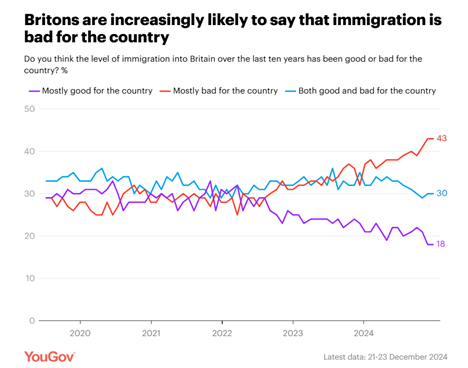 |
(YouGov UK)
January 02, 2025
Source:https://yougov.co.uk/politics/articles/51211-where-public-opinion-stands-at-the-beginning-of-2025
880-881-43-06/Polls
Living With Artificial Intelligence: Opportunity Or
Threat?
In order to better
understand the perception of artificial intelligence (AI) around the world,
Ipsos conducted a major survey in 11 countries for the 21st edition of the
Royaumont Interviews. The results highlight a mix of enthusiasm and fear
regarding this technology, with more marked concern in France. Overall,
emerging countries appear, as is often the case with technology, more
enthusiastic than advanced economies. But everywhere, there is a consensus on
the need to regulate AI. As for the uses of AI, they are popular in medicine
and education – but contested in terms of hiring/firing, granting loans or
allocating places in educational establishments.
As much enthusiasm as concern
about AI
This is the first
observation of this study: if two-thirds of respondents (66%) believe that AI
will bring opportunities and solutions, half (50%) say they are afraid of
it.

Concern
is high everywhere – but particularly in France, where three-quarters of
respondents say they fear the impact AI will have on the world they live in.
Only the Japanese and Chinese say they are mostly confident. Everywhere,
fears are more about the consequences on the world than on the personal lives
of those surveyed.

Emerging countries are more
positive about AI
As is often the case with technology issues, emerging
economies are more confident: the share of people saying they are
enthusiastic about AI is significantly higher.
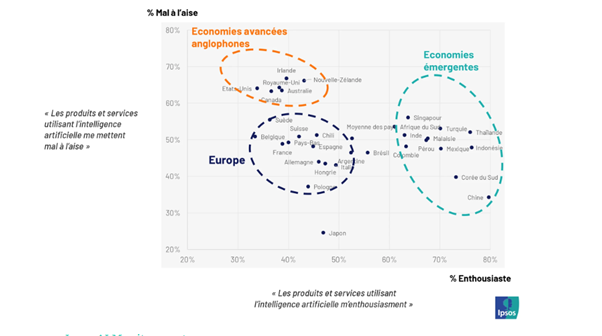
There is consensus on the need
to regulate AI
Across the 11 countries surveyed, nearly 9 in 10 people say
they support regulating AI through legislation. Reasons include protecting
against aggressive business practices, safeguarding individual freedoms and
preserving privacy.
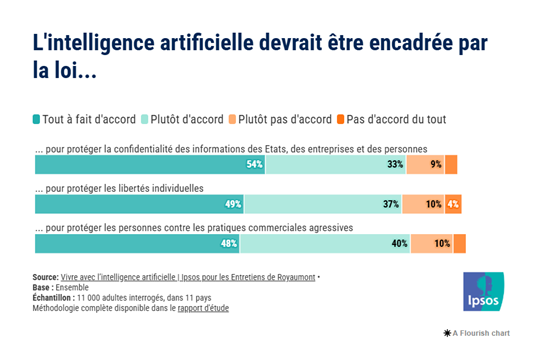
Popular uses and contested ones
The use of AI in medicine (69% of people in favor) and in
education (64%) is widely approved. On the other hand, its use for hiring and
firing decisions (42%), allocation of places in educational establishments
(50%) or granting loans (51%) raises more reservations. The French are among
the most reluctant to see AI intervene in these areas.
The use of AI for military purposes gives rise to questions – but it remains
supported by two-thirds of respondents (67%).

(Ipsos France)
January 08, 2025
Source:https://www.ipsos.com/fr-fr/vivre-avec-lintelligence-artificielle-opportunite-ou-menace
880-881-43-07/Polls
Bank & Insurance Brand Mover December 2024
YouGov
BrandIndex, the YouGov tracker that monitors the health of hundreds of brands
in Italy on a daily basis, has identified the brand that, in the Bank &
Insurance sector, has grown significantly in the last month compared to the
previous month: Buddybank is the Bank & Insurance Brand Mover for
December 2024.
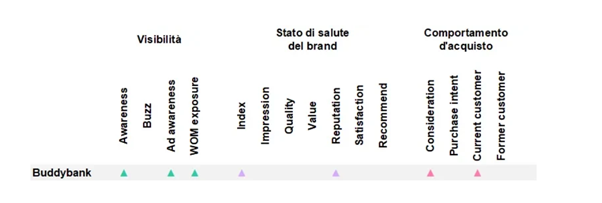
In
December, several reach metrics saw significant growth, including Awareness, Ad Recall, and WOM
Exposure. These indicators increased significantly compared to the
previous month (November), likely driven by Davis Cup sponsorship activities
and continued social media activity.
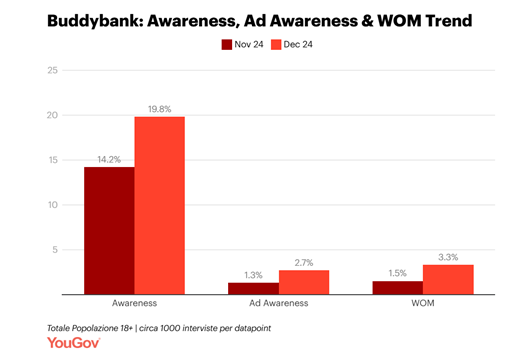
The Index, or the aggregate score of the health of the brand
(brand equity), also improved significantly. This growth was driven by the
notable improvement in the Reputation metric,
which recorded a considerable increase compared to the previous month, more
than doubling its value.

Finally,
compared to the previous month, two of our reaction metrics also improved
significantly: the consideration for purchasing the brand ( Consideration ) and, consequently, the customer base
( Current Customer ). Both
recorded their highest peak in the last six months in December
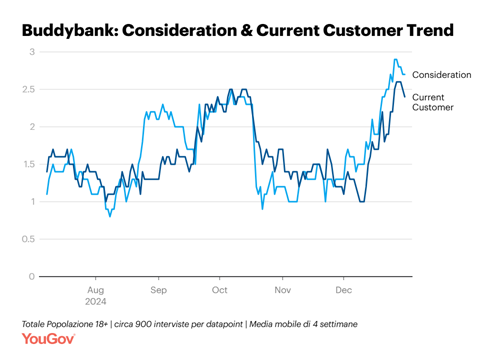
(YouGov Italy)
January 08, 2025
Source:https://it.yougov.com/economy/articles/51269-buddybank-bank-insurance-brand-mover-di-dicembre-2024
880-881-43-08/Polls
Worry About Violent Crime, Wanting To Have A Gun, If
The Police Come
Short summary
45% of the Swedish people state that they have become much more
(10%) or more (35%) unsafe in recent years. The biggest reason for the
concern is crime (53%), war (29%) and violent crime (27%). This concern
results in 1.6 million Swedes 21% want firearms to defend themselves, 14% to
defend themselves at home, but 7% would like to have the right to defend
themselves with firearms both at home and outdoors. An explanation for this,
in addition to the increase in violent crime, is also that 65% of Swedes do
not believe that the police will arrive in time if they themselves are the
victim of a crime.
It's a whole new Sweden that's emerging, one where you have to
take care of yourself. Read more about the survey and my analysis below.
Torbjörn Sjöström
CEO Novus
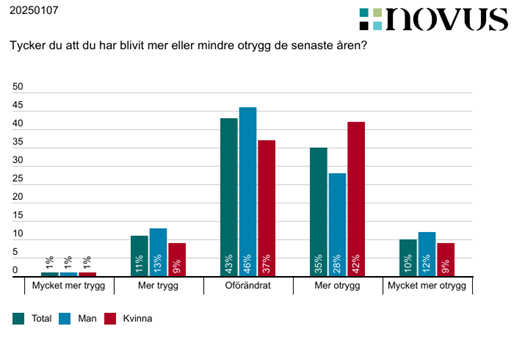
Almost every second Swede, 45%, believes they have become more
insecure in recent years. Women (51%) to a higher degree than men (39%)
Young (18-34) men and women say they have become safer in recent
years. Especially men, where 27% say they have become safer, 19% among women.
The most insecure are women aged 50-64.
Geographically, it is in northern Sweden where security has
increased the most. There 23% have become more secure. But those who are
decreasing are not those who have become more unsafe, but rather a lower
proportion who state that it is unchanged there. So it is more polarized in
the north, you either feel more secure or more unsafe.
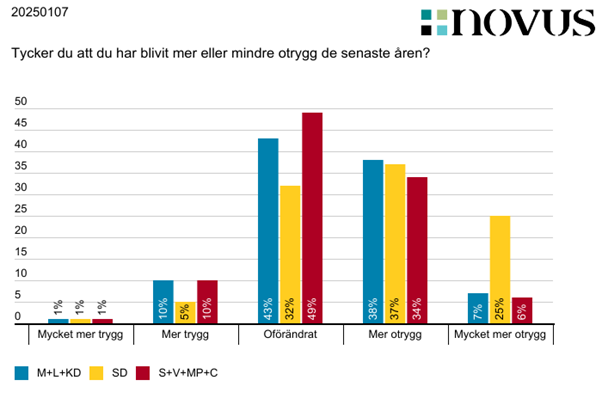
SD's supporters stand out for their insecurity, which is nothing
new, we have seen this all along, but SD has grown over the years and among
them, one in four supporters say they feel much more insecure in recent
years. A stark contrast to supporters of both the government parties and the
opposition.

Every second Swede states that crime is what makes them most
insecure, in second place almost every third (29%) states that it is war and
27% state that it is violent crime.
17% mention the climate, but an equal number of 16% mention
terrorism, and not far behind are 13% who state that politicians create
insecurity.
At the bottom of the list are the pandemic and the police. The police are
basically not something that anyone is worried about, and they are also the
ones who enjoy the highest trust in Sweden in other surveys. Something that
may be worth remembering from an international perspective. But it does not
explain the expectations. The police are the ones responsible for counteracting
three of the five issues that create the most concern among the Swedish
people. 45% of Swedes have also become more worried in recent years.

Broken down by party affiliation, the political division is most
clearly visible. Among supporters of the main parties, seven out of ten state
that crime is what creates the greatest concern. It is also what worries
opposition supporters, but only four out of ten state it. Opposition party
supporters are more concerned about global threats, both war and the climate
are significantly more of a concern than supporters of the main parties.
One difference between the government and the supporting party
SD is that concern about violent crime is higher among SD's sympathizers,
although 31% of the government parties' sympathizers are worried about it, it
is lower than among SD's sympathizers where almost every second person (47%)
is worried about it.
Violent crime should also be interpreted as a greater concern
about being exposed to this yourself, which we see in a later question in the
survey. Crime is a broader concept, where it can affect Sweden, as we know
from previous surveys that people are worried about the impact on Sweden more
than on their own individual, but we also see that the concern is creeping
closer.
It is worth noting that SD supporters are less worried about war
than others, only 11% state that it is in the top two. But on the other hand,
it may also be because they are more worried about violent crime, almost
every second SD supporter has it as one of the two things that causes the
most concern.
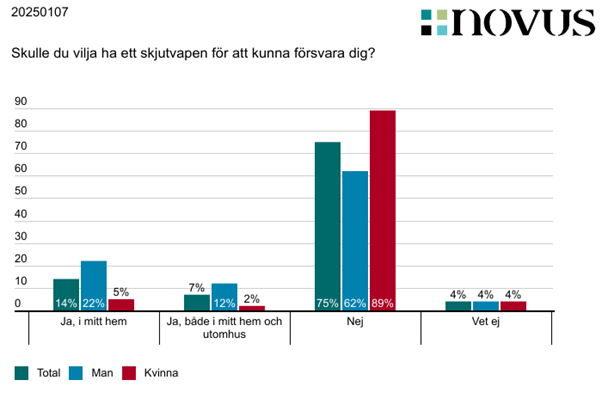
1.6 million
Swedes (21%) would like to have a firearm to defend themselves, 14% in their
home, and 7% both at home and outdoors. These are shocking results that may
be difficult to understand that it is in Sweden. But Novus has previously
investigated the issue of being allowed to use weapons to defend themselves
in their home. In April 2024, 13%
stated that they should be allowed to have one, now 21% state that they
themselves would like to have one. So Novus has followed this
development for a few years, starting with the view of the will to defend
themselves when Ukraine was invaded. Then we investigated whether people
should be allowed to have firearms. Now we are following up in an attempt to
further try to understand what the increasing insecurity means in concrete
terms. If you yourself want to have firearms. That 21% of all Swedes would
now like to have a firearm to defend themselves is shockingly high, but a
direct reaction to the growing anxiety and the feeling that you yourself will
not get help if you need it. In Sweden, you generally do not have the right
to defend yourself with a firearm, this is something that you would probably
expect more from studies in the USA, where you have the right to defend
yourself with a firearm. Sweden has a high gun density, about 600,000 Swedes
have guns linked to hunting and also to some extent to shooting sports, but
this is linked to leisure interests, not defense.
This increase can probably be explained primarily by the
increased proportion of serious violent crimes, but also by the fact that the
authorities are placing more and more responsibility on the individual in
times of crisis and war. That the state has backed away from its
responsibility for citizens. Both communicatively, but also concretely.
During the pandemic, trust in healthcare was sky-high, but people were also
taught that they had no time for anyone except the terminally ill, so people
stayed home and avoided seeking care so as not to disrupt healthcare. Now
this has been transferred to crime, where the police have a high level of
trust. But people do not believe they can help individuals who need help.
Expectations are extremely low. The police, just like healthcare, are busy
with everyone else, not you. You are expected to take care of yourself.
Something that politicians have also communicated. Both around violent crimes
and healthcare, but also around, for example, electricity prices, where it is
up to the individual to adapt. The state does not seem to be able to do its
job. From a cultural perspective, this is something that clashes with
collectivist Swedes. Where it is deeply rooted that we pay taxes and trust
the system, but a system that increasingly places a greater burden on the
individual. Which is actually the explanation for the SD's strong growth.
More and more signs that confirm that the Sweden you grew up in no longer
exists. That society is no longer stable. Even though society proved that it
was more stable than people thought during the pandemic, politicians and
authorities have unfortunately not learned that it is important to show that
they can deliver. Instead, they unfortunately incorrectly concluded that you
can trust even more the individual who stood up. But it confirms for even
more people that you have to take care of yourself, society does not exist
for you. But for "the others" a small group outside that does not
include the overwhelming majority who have to stand back and pay taxes but
also spend more and more time and energy on their own self-sufficiency and
defense...
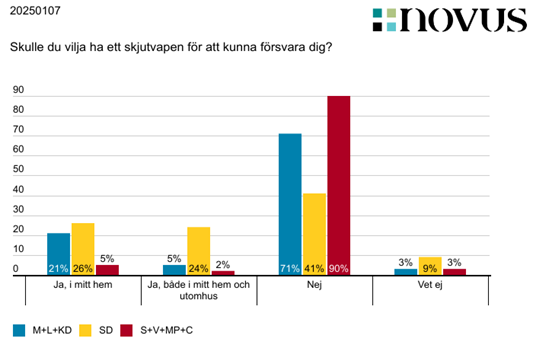
Among the ruling parties, 21% believe they want to have a
firearm at home to defend themselves, 26% of SD supporters also believe so.
Only 5% of opposition supporters want it. SD supporters are not only
distinguished by being driven by concern about violent crime, every fourth
(24%) SD supporter would also like to have a firearm to defend themselves
both at home and outdoors.
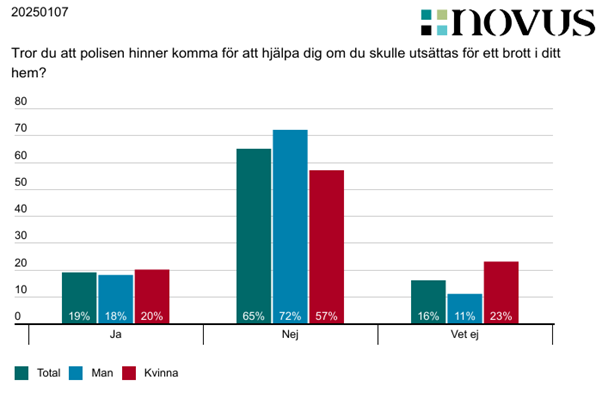
65% of Swedes do not believe that the police will arrive in time
to help if they are the victim of a crime in their home. Here we have further
confirmation that expectations in society have dropped despite the fact that
trust in the police is extremely high. "They do the best they can, but
they don't have time for me". An overwhelming majority therefore do not
believe that the police will arrive in time if they are needed. Which also
explains the desire for a firearm.
What Swedes see emerging is a completely different society, with
daily shootings, a society that takes citizens for granted, but you have to
take care of yourself. Clearly encouraged by authorities such as MSB who say
you have to take care of yourself. And you should not interfere with
healthcare or the police, even though trust is high, but you have lost faith
in their ability to deliver for the citizen.
However, one in five Swedes (19%) believe that the police will
arrive in time. However, an equal number of 17% say they do not know.
The question behind this is what to expect from society? Should
they create security and care for citizens? Should they be able to handle it?
Can they handle it? Is it a communication problem, that the concern is
unfounded? In that case, we need to think about how to increase the feeling
among citizens that society is delivering. But at the same time, we also need
to stop saying that citizens should be able to handle it more and more on
their own if we do not want to simultaneously lower the willingness to pay
taxes to the collective. Swedes are uniquely collectivist, and the
willingness to believe in the system is internationally sky-high, but we are
seeing more and more cracks in the wall. Wanting to have firearms to defend
themselves and that a clear majority does not believe that the police will
come are clear signals that a large part of the Swedish people have already
realized that they can no longer trust the system.
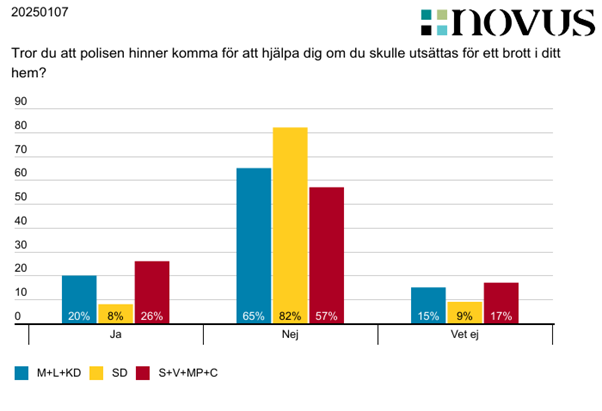
There is a clear political division between the Tidö parties and
the opposition.
But the election was largely about which worldview one believed
in. One that was dominated by threats and crime nationally or one that was
about global challenges and that one was not worried about these threats.
Sweden was divided into almost two equal parts. In the same way, there was
also a gender division, between predominantly male and female problems.
Although it cannot be directly translated into government support and
opposition, S worked to also attract men and counteract this bias. But
despite that, there is an interesting gender dimension that is also clear in
this survey, both in the concern and the desire to defend oneself against
these threats.
(Novus)
January 07,
2025
Source:https://novus.se/egnaundersokningar-arkiv/oro-for-valdsbrott-vilja-att-ha-vapen-om-polisen-kommer/
880-881-43-09/Polls
Tipping Points In The Climate Transition: Is The
Netherlands Ready For The Acceleration?
The road to a more sustainable future
often seems slow and bumpy, until a crucial moment accelerates everything.
This so-called tipping point – where a long, silent build-up of change
suddenly causes a major shift – is a fascinating phenomenon. A recent study,
conducted by Motivaction on behalf of Triodos Bank , makes it clear that the
Netherlands may be closer to these sustainable tipping points than many
think.
What do the numbers say?
A survey among a thousand Dutch people shows that almost half
(49%) agree with the statement that CO2 emissions should be reduced much
faster than is currently happening. This number is larger than the group that
disagrees (20%). Although a third of the respondents are still undecided,
this shows that the majority is open to accelerating the climate transition.
However, the research also shows that behavior often lags
behind intentions. The willingness to change is there, but actual action is
lacking, unless sustainable choices are made cheaper or mandatory. This
underlines the power of financial incentives and regulations to accelerate
transitions.
The five major transitions
The Triodos report identifies five areas where major changes
are needed:
1. Energy: The transition to renewable
sources such as solar and wind energy.
2. Raw
materials: Steps
towards a circular economy.
3. Food: Eat more local and
plant-based.
4. Society: More social cohesion and
involvement in communities.
5. Wellbeing: Focus on health and quality
of life rather than purely economic growth.
Interestingly enough, in the Netherlands there is often more
support for change than resistance. For example, almost three quarters of the
Dutch believe that a healthy lifestyle should be the norm. There is broad
support for initiatives such as the right to repair electronics. At the same
time, there are topics, such as a meat tax or car sharing, that are met with
much resistance.
What can we learn?
A striking conclusion from the research is that social tipping
points often do not wait for a majority, but can already be initiated by a
significant minority of around 25%. This offers hope for policymakers and
companies that want to stimulate change. However, it also emphasizes the
importance of responding smartly to what people are already prepared to do.
Working together on change
The climate transition may seem complex and slow, but the
signs of hope are clearly visible. By aligning policies and initiatives with
people’s willingness, we can accelerate the transition to a more sustainable
society. As the report concludes: the potential for rapid and radical change
is there – it is up to us to seize the opportunity.
(Motivaction Insights and Strategy)
January 07, 2025
NORTH AMERICA
880-881-43-10/Polls
Americans Think History Will Rate Biden Presidency
Negatively
Many more Americans expect history to judge Joe Biden’s
presidency unfavorably rather than favorably. Fifty-four percent of U.S.
adults believe Biden will be remembered as a “below average” (17%) or “poor”
(37%) president, while 19% say he will be evaluated as “outstanding” (6%) or
“above average” (13%). Another 26% think he will be regarded as “average.”
Compared with nine recent presidents included in the new Gallup
poll, Biden rates most similarly to Richard Nixon, who has a -42 net rating
(12% outstanding or above average versus 54% below average or poor). Biden
receives more “poor” reviews than Nixon does (37% vs. 30%), but Biden gets
more outstanding or above-average ratings.
George W. Bush and Donald Trump also receive more negative than
positive evaluations among recent presidents, with Trump getting both
relatively high positive (40%) and negative ratings (44%) for his first term
and the fewest average ones (16%). Trump’s 31% “poor” ratings are similar to
those of Nixon, but Trump’s 17% “outstanding” ratings are higher than for
most other presidents.
John Kennedy is rated best by Americans – with a net rating of
+68, while Ronald Reagan (+38) and Barack Obama (+21) also get substantially
favorable reviews.
![]()
The results are based on a Dec. 2-18 Gallup poll. The poll was
completed before the Dec. 29 passing of Jimmy Carter,
which could have affected the way people remember his presidency. Carter,
along with Bill Clinton and George H.W. Bush, receives slightly more
outstanding or above-average ratings from Americans than below-average or
poor ones.
Democrats Give
Biden Tepid Review; Republicans Overwhelmingly Critical
More Democrats expect history to look kindly rather than
critically on the Biden presidency -- 44% think it will be judged outstanding
or above average, while 16% say below average or poor. But nearly as many
Democrats believe Biden will be remembered as an “average” president (38%) as
a good one.
Independents and Republicans are much more pessimistic in their
evaluations of Biden’s presidency. The slim majority of independents, 51%,
believe Biden will get a negative historical review, compared with 15% who
think he’ll get a positive one. Republicans overwhelmingly expect history to
judge Biden harshly, including 76% who say he will be regarded as a “poor”
president and 17% below average.
![]()
Democrats’ +28 net rating of Biden’s presidency is significantly
lower than their ratings of other recent Democratic presidents, with Clinton
at +43 being the next lowest. Biden is the only recent Democrat with a
net-negative rating among political independents, and his -92 net rating
among Republicans is more than 40 points worse than for any other Democratic
president.
Kennedy is the only president to get a positive review among
supporters of the opposition party. In fact, Republicans rate Kennedy
similarly to Democrats, and better than independents do. Democrats rate Obama
as the best of the Democratic presidents.
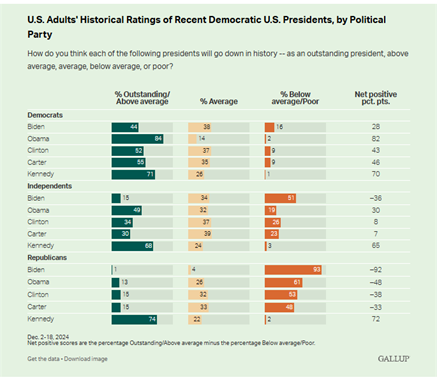
Among Republican presidents, Trump receives the most sharply
polarized ratings, even more so than Biden does among Democratic presidents.
Republicans believe Trump is on par with Reagan as having the best
presidential legacy. In contrast, Democrats believe history will judge
Trump’s first term worse than Nixon’s presidency. More independents expect
Trump to receive a negative than positive evaluation, but independents rate
Nixon worse.
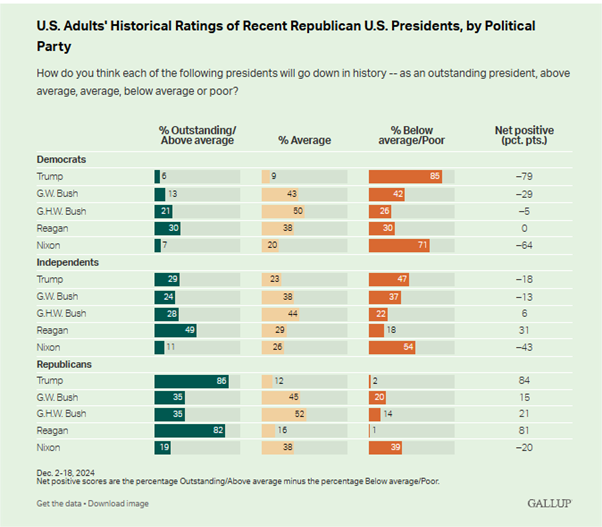
Reagan is the only Republican president that Democrats do not
evaluate negatively, though the elder George Bush also gets relatively
neutral ratings from Democrats. Independents rate two Republican presidents
-- Reagan and the elder Bush -- positively on balance.
Nixon is the only president to be rated more negatively than
positively by his own party’s supporters. Republicans are much less
charitable in their evaluations of the two Bush presidents than of Trump and
Reagan, but still view them positively overall.
Trump First
Term Rated Much Better Now Than When It Ended
Trump’s ratings have improved substantially from when he left office in
January 2021 in the wake of the Jan. 6 attack on the Capitol
and the peak in U.S. deaths from COVID-19. At that time, 29% of Americans
thought history would judge Trump as an outstanding or above-average
president, 10% as average, and 61% below average or poor.
The -32 net rating Trump had in 2021 has improved to -4. Since
2021, there has been a larger decrease in below-average or poor evaluations
of Trump’s first term (down 17 points) than an increase in outstanding or
above-average ratings (up 11 points).
The biggest decline in below-average or poor ratings of Trump
has come among independents (falling from 63% to 47%), but all party groups
show meaningful declines in negative assessments of his first term. Most of
the increase in outstanding or above-average ratings has come among
Republicans, from 72% to 86%.

Trump is not the only president whose historical legacy
assessments have improved compared with how they were rated at the end of
their presidency.
●
George W. Bush’s ratings when he left
office in 2009 were similar to what Biden’s are now -- 59% negative and 17%
positive. But the gap between negative and positive ratings of Bush has
narrowed to nine points (24% positive, 33% negative).
●
Carter had a 14% positive rating and
46% negative rating in December 1980, but now gets more positive than
negative ratings.
●
Opinions of Obama’s presidency are
slightly better now than in 2017 due to lower below-average or poor ratings.
Reagan’s evaluations haven’t changed much since his presidency
ended, while those for George H.W. Bush and Clinton have worsened.
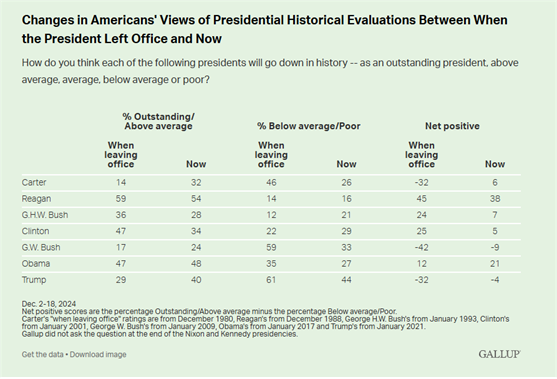
Bottom Line
Americans do not expect history to be kind when it judges
Biden’s presidency. Right now, he is evaluated similarly to Nixon, who
resigned from the White House amid the Watergate scandal. Biden’s fellow
Democrats are less enthusiastic about his presidency than they are about
other recent Democratic presidents, and Biden is the only recent Democratic
president who currently has a net-negative evaluation among independents.
However, past presidents who finished challenging terms, including Carter,
George W. Bush and Trump, have seen the harsh ratings they received at the
time they left the White House soften considerably over time.
(Gallup)
January 07, 2025
Source: https://news.gallup.com/poll/654878/americans-think-history-rate-biden-presidency-negatively.aspx
880-881-43-11/Polls
What The Data Says About Federal Workers
President-elect Donald Trump has focused much attention on
shrinking the size and scope of the federal government for his second
administration.
Most notably, Trump has appointed tech mogul Elon Musk and
GOP-primary-rival-turned-ally Vivek Ramaswamy to lead an advisory task force
dubbed the “Department of Government Efficiency.” Musk and Ramaswamy have
said they aim to cut trillions of dollars from the federal budget,
abolish or consolidate hundreds of federal agencies, and slash the federal
payroll by as much as 75%.
As Trump returns to the White House, here are answers to some
common questions about the federal workforce, based on data from the Office
of Personnel Management (OPM) – the federal government’s human resources
department – and the Bureau of Labor Statistics (BLS). Unless
otherwise stated, all figures in this analysis are as of March 2024.
How many federal workers are
there?
That depends on who you’re counting.
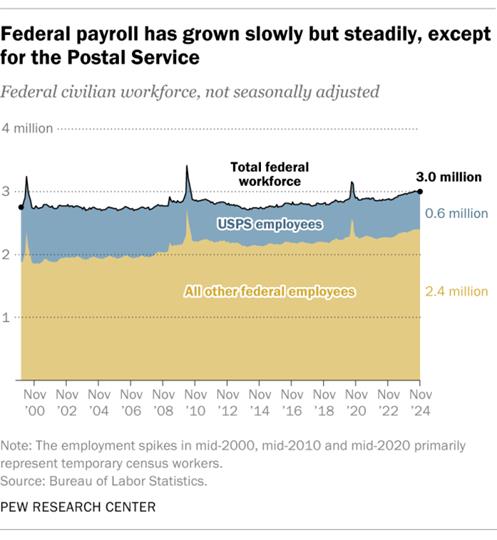
In November 2024, the federal government employed just over 3
million people, or 1.87% of the entire civilian workforce, according to BLS
data. That figure doesn’t count the roughly 1.3
million active-duty military personnel, who aren’t typically considered “employees.” It does include the more than 600,000 people who work
for the U.S. Postal Service, an independent federal agency with semiautonomous status that operates somewhat like
a private business.
Set aside the Postal Service and you have a bit more than 2.4
million federal workers. That makes the federal government the nation’s
single largest employer, with even more workers than Walmart, Amazon or
McDonald’s. In fact, the Postal Service by itself would, if it were a private
business, rank among the 10 largest private-sector employers, ahead of
industry rivals UPS and FedEx.
Detailed information on most executive-branch workers –
2,278,730 as of March 2024 – is available through OPM’s FedScope data portal. The rest of this analysis draws
mostly from that database. FedScope doesn’t include postal workers,
congressional staffers, employees of the government’s various intelligence
agencies or presidential appointees who require Senate confirmation.
How has the number of federal
workers changed over time?
In absolute terms, it has risen fairly steadily for decades.
In November 2000, federal employment – excluding the Postal Service – stood
at 1,855,900 people, according to BLS data. That number has grown by a little
over 1% each year since then, to 2,405,100 people in March 2024.
While the number of
federal workers has grown over time, their share of
the civilian workforce has generally held steady in recent years. The federal
government (again excluding the Postal Service) accounts for 1.5% of total
civilian employment, a share that – except for a temporary bump in mid-2020
for the decennial census – has been largely constant for more than a decade.
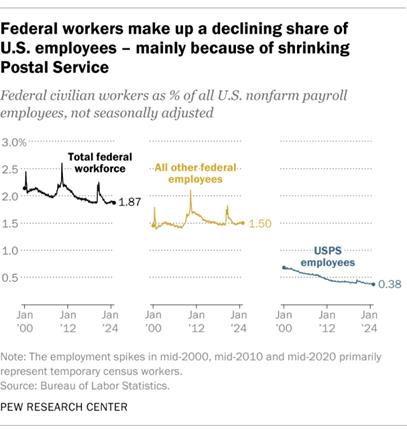
The Postal Service’s workforce, on the other hand, has fallen
by a third since peaking at a seasonally adjusted 909,000 in April 1999.
Despite the agency’s announced intentions
to reduce headcount, Postal Service employment has hovered around 600,000
for more than a decade. (We used seasonally adjusted figures for this
calculation because Postal Service payroll tends to bump up every December
during the busy holiday season.)
Related: The state of the U.S. Postal Service in 8 charts
Which federal departments and
agencies employ the most people?
The Department
of Veterans Affairs employs more than 486,000 people, giving it by
far the largest payroll of the 18 Cabinet-level departments (noting that OPM
counts the Army, Navy and Air Force departments separately). Most of these
employees work for the Veterans Health Administration, which operates the VA’s
extensive network of hospitals, clinics and nursing homes.
The smallest Cabinet-level department, with 4,245 workers, is
the Department of Education. Trump, like many previous
Republican presidents, has proposed abolishing
the department entirely.
Among independent agencies, the largest employer is the Social Security Administration, with more than 59,000 workers.
That’s more than the combined total of five Cabinet-level departments:
Education, Energy, Labor, State, and Housing and Urban Development.
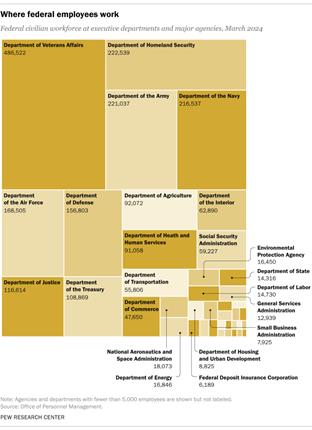
Are most federal workers in the
Washington, D.C., area?
Not by a long shot. Fewer than a
fifth of the workers in OPM’s database – about 449,500 – work in the District
of Columbia or the adjoining states of Maryland and Virginia. Outside that
region, California and Texas have the largest contingents of federal
employees, with about 147,500 and 130,000, respectively. About 30,800 federal
employees work overseas.
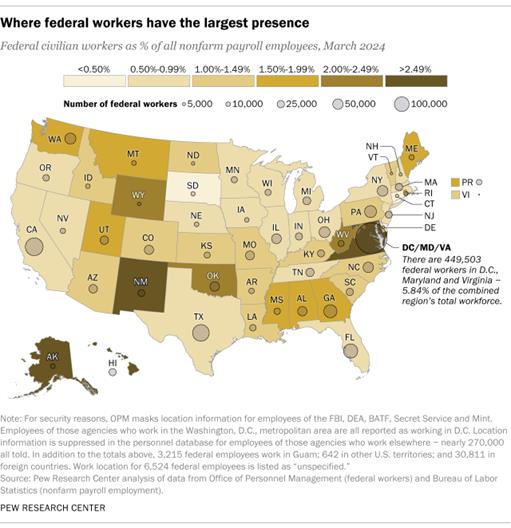
How do federal workers compare
demographically with American workers as a whole?
The federal workforce is slightly more male: 53.8%, versus
52.8% for all civilian workers. It also skews somewhat older: 28.1% of
federal workers are ages 55 and older, compared with 23.6% of the overall
workforce. Fewer than 9% of federal employees are younger than 30, compared
with 22.7% of all workers.
Racially and ethnically, the federal workforce largely mirrors
the overall civilian workforce, with two notable exceptions: A bigger share
of federal workers are Black (18.6% vs. 12.8%), and a smaller share are
Hispanic or Latino (10.5% vs. 19.5%).
As a whole, federal workers are more educated than the overall
civilian workforce. Nearly a third of federal workers (31.5%) have a
bachelor’s degree, compared with 27.7% of all employed Americans. And almost
22% of federal workers have an advanced degree, versus 17.6% of all workers.
The most highly educated federal agency, among those with at
least 1,000 employees, isn’t NASA or the National Science Foundation, but
the U.S. Agency for International
Development.
Two-thirds of its 4,675 workers hold a master’s degree, doctorate or other
advanced degree.
What kinds of work do federal
employees do?
Almost all federal employees (92%) are considered “white
collar” workers – that is, in professional, administrative, technical,
clerical or similar jobs. But the range of specific federal occupations runs
literally from A (740 able seamen) to Z (43 zoologists).
Nearly 364,000 federal employees, or 16% of the federal
workforce, are in health-related fields – the single largest occupational
category. By contrast, only 134,239 federal workers, or 5.9%, are classified
as lawyers or in law-related jobs.
Out of more than 660 specific occupations that OPM lists, the
most common are nursing and “miscellaneous administration and program work,”
both with more than 111,000 workers; and information technology management,
with about 99,000 workers. The federal government also employs some 14,000
custodial workers, about 2,500 welders, 580 cartographers and 21 bakers.

How much do federal workers
earn?
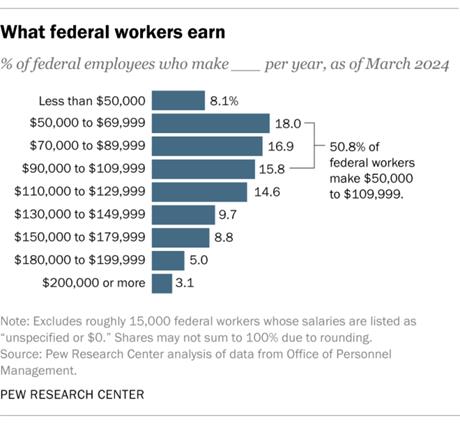
The average annual pay across the entire federal workforce is
$106,382, according to OPM, reflecting the skew toward white-collar jobs held
by highly educated people. Half of all federal workers make between $50,000
and $109,999 a year. Relatively few (3%) make $200,000 or more, while 8% make
less than $50,000.
Pay varies considerably based on what federal workers do and
in which office or agency they work. Consider, for example, the agencies with
the highest and lowest average salaries:
▪
The Commodity Futures Trading Commission, which regulates futures
contracts, swaps and other derivatives markets, employs 736 people who make
an average of $235,910 a year. Nearly all of the CFTC’s workers are in
professional or administrative jobs, including 273 attorneys, 122 in “general
business and industry,” 68 information technology management workers, 43
auditors and 32 economists.
▪
The Armed Forces Retirement Home, which despite its singular name
operates two retirement centers for
veterans, employs 306 people who make an average of $75,151 a year. Most of
its workers are in health care, including 153 nurses, practical nurses and
nursing assistants.
What does job tenure look like
among federal workers?
More than half of federal workers (1.18 million, or 51.8%)
have worked for the government (in any civilian capacity) for less than 10
years, according to our analysis of the OPM data. The average tenure across
the entire workforce is 11.8 years, but this too varies considerably from
agency to agency.
▪
The highest average length of
service, among agencies with at least 100 employees, is at the United States Holocaust Memorial Museum in Washington, D.C. The
museum, which opened in 1993, has 117 employees with an average tenure of
21.8 years.
▪
AmeriCorps, the domestic volunteerism
agency formally known as the Corporation for National and Community Service,
has the shortest average length of service among major agencies. Its 785
workers have an average tenure of 7.5 years.
For comparison, the median job tenure for all U.S. wage and
salary workers is 3.9 years, according to BLS data.
Do all federal workers have
civil service protections?
Most, but not all, have these protections, which shield
workers against being disciplined or fired except for just cause. Civil
service protections also create specific procedures that agency employers
must follow before firing or disciplining employees.
About two-thirds of federal workers (1.5 million, or 67.3%)
are in what’s called the “competitive service,” meaning that job applicants
compete for positions and are evaluated based on objective criteria, such as
written exams. Once they pass a probationary period, employees in the
competitive service can’t be fired, suspended, demoted or subjected to other
“adverse actions” without cause. They also have the right to written notice
of such adverse actions and can respond to or appeal them.
Around 8,700 federal workers (0.4%) are in a special
classification called the “Senior Executive Service,” or SES. These
high-level employees manage major programs and projects, and they often serve
as intermediaries between presidential appointees and career civil servants.
▪
About 90% of SES employees come
from the ranks of the career federal workforce. In general, they can only be
fired for misconduct, neglect of duty, malfeasance, or refusal to accept a
transfer or reassignment. They can, however, be removed from the SES for
unsatisfactory job performance.
▪
About 10% of SES employees
(around 850) are non-career federal workers or have been hired for a limited
time. They can, in most cases, be fired or removed from the SES at the
discretion of the head of their agency.
All other workers – roughly 735,000, or 32.2% – are considered
“excepted service” employees, meaning their jobs have been exempted from the
regular hiring rules. That’s often because their positions require specific
skills and it’s considered impractical to examine applicants. Lawyers,
teachers and chaplains, for example, often fall into this category.
Also part of the excepted service are employees in jobs of a
“confidential or policy-determining character.” Most political appointees to
positions that don’t require Senate confirmation are in this category.
Generally speaking, excepted service employees – except for the political appointees referred to above
– have the same notice and appeal rights as workers in the competitive
service. However, in most cases, those rights don’t become effective until
after the worker has been on the job for at least two years, which in
practice makes them easier to discipline or fire.
Late in Trump’s first term, he issued
an executive order that would have allowed agencies to move certain
career employees – those whose jobs were determined to be of a “confidential,
policy-determining, policy-making or policy-advocating character” – into a
new category of the excepted service. That would have made them easier to
hire, discipline or fire, outside the usual civil-service rules. Estimates
were that tens
of thousands of
career employees could have been reclassified under the plan.
President Joe Biden revoked Trump’s order upon taking office,
and earlier this year his administration adopted
a new rule aimed
at protecting career employees from being moved involuntarily to a
classification with fewer job protections. However, Trump has said he
will reissue
the order in
his second term.
How do Americans feel about
federal workers?
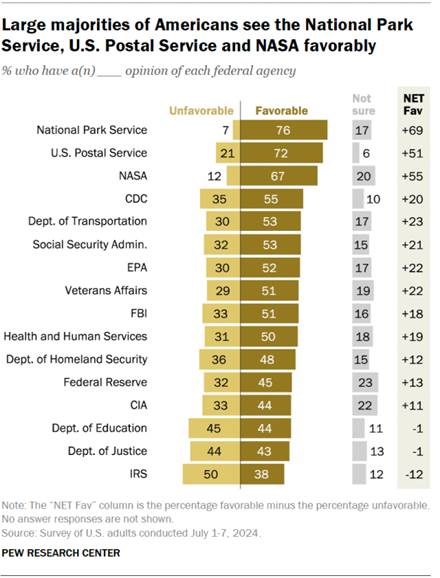
Pew Research Center has regularly asked Americans about their
views on the size and scope of government, their opinions of specific federal
departments and agencies, and even whether they have more confidence in
career employees or political appointees. Their responses indicate that
Americans have, at best, mixed feelings about federal employees and the
agencies they work for.
▪
Americans are evenly
divided on
government’s size and scope: 49% say they’d prefer a smaller government that
provides fewer services, while 48% say they’d prefer a larger government that
provides more services, according to a survey conducted in April 2024.
▪
A majority (56%) say government
is “almost always wasteful and inefficient,” while 46% say it often does a
better job than people give it credit for.
▪
But 53% also say the government
should do more to solve problems, while 46% say the government is doing too
many things better left to businesses and individuals.
▪
Strong majorities express positive
views of many federal agencies, including the National Park Service (76% favorable),
the Postal Service (72%) and NASA (67%). Sentiment is more mixed toward other
agencies, such as the CIA (44% favorable vs. 33% unfavorable) and the
Education Department (44% vs. 45%). And sentiment is decidedly negative
toward the IRS (38% vs. 50%).
▪
In a 2022
survey,
more people expressed a great deal or a fair amount of confidence in career
government employees (52%) than in officials appointed by the president
(39%). However, both those figures were down from 2018 (61% and 42%,
respectively).
(PEW)
January 07, 2025
Source:https://www.pewresearch.org/short-reads/2025/01/07/what-the-data-says-about-federal-workers/
880-881-43-12/Polls
Will Canada Move Beyond Disruption In 2025?
Our clients influence the lives of Canadians every day. We see
our job at Ipsos as helping you, our clients, gain the insights you need to
make decisions. We also think that the breadth of what we do and our
perspective on Canadians as both citizens and consumers can help our clients
navigate what is an increasingly uncertain world. As we at Ipsos take stock
of the year that was 2024, we are struck by a few broader themes.
First, it’s hard to be optimistic when you are
looking at the data we are looking at. That does not mean 2025 will be all doom and
gloom. There will be some bright spots, but the phrase “hope springs eternal”
seems to be out of sync with the views of Canadians and the positions of our
political leaders. Much of the political and economic narrative is about
supporting those in need, fixing the things that are broken or righting the
wrongs that have been done. Little today seems aspirational.
Second, public opinion matters, it shapes
events. What
the public was feeling, their hopes and fears were reflected in the actions
of politicians and businesses throughout the year. Affordability and
immigration were among the top concerns and while Canada’s leaders have
started to respond, the jury is out as to whether these actions will have an
impact on the mood or the finances of Canadians. Climate Change remains
important to Canadians but lacks urgency and with no consensus on what can be
done about it, we have seen political leaders campaigning for removal of a
price on carbon.
Third, context matters. The best laid plans can
succeed or fail depending on the context in which they are unveiled. Or to
steal a quote from Mike Tyson, “Everyone has a plan until they get punched in
the face”. We can see the impact of context in how we react to extreme
weather events or Canadians’ response to the “GST Holiday”. Severe storms are
becoming common place and haven’t resulted in increased concern over climate
change. The temporary GST break pales in comparison to the feelings of
declining purchasing power Canadians have experienced. Looking ahead, the
2025 “contextual punch” may well have already been delivered by the US
electorate.
Despite what has been a busy and disruptive year we think 2024
will be remembered as the first true post-pandemic year.
(Ipsos Canada)
December 30, 2024
Source: https://www.ipsos.com/en-ca/will-canada-move-beyond-disruption-2025
880-881-43-13/Polls
7 Out Of 10 Brazilians Believe That 2025 Will Be A
Better Year
The Ipsos Predictions 2025 survey revealed data on global
expectations and perceptions for the year 2025. According to the survey, 2024
was a challenging year for many Brazilians. 65% of the Brazilian population
assessed 2024 as a bad year for the country and 53% as a bad year for
themselves and their families. In both questions, Brazilian perceptions are
in line with global averages – 65% and 51%, respectively.
Despite the more critical view of the majority of Brazilians
towards the year that is ending, the population shows hope for the future,
standing out in optimism in several areas for 2025.
The survey also shows that polarization should continue to be
a recurring issue. 62% of Brazilians do not believe that people will be more
tolerant of different views.
Positive expectations about the future
The survey reveals that 79% of Brazilians believe that 2025
will be a more promising year than the current one, a rate that exceeds the
global average of 71% and demonstrates confidence in a more positive
scenario.
Furthermore, 60% of Brazilians agree with the statement that
“the global economy will be stronger in 2025 than in 2024”, a percentage that
is also higher than the global average, which is 51%.
Another relevant fact is that 82% of Brazilians intend to set
personal resolutions for the coming year, a rate that also exceeds the global
average of 75%. This behavior reinforces the population's willingness to seek
changes and improvements in their lives, even in the face of a scenario that
is still uncertain.
Confidence in the economy and consumption
Rising prices, inflation and interest rates are very relevant
points in the perception of the interviewees. 73% of Brazilians believe that,
in general, the prices of products and services will increase much more than
people's income. 72% believe that in 2025, interest rates will be higher than
the current year, and 67% believe that inflation will be higher next year,
which signals a perception of persistent challenges in controlling the cost
of living.
Health and well-being in the spotlight
The survey revealed significant optimism regarding health.
While 81% of Brazilians believe that their physical health will be better by
2025, 79% share the same outlook for mental health. This positive thinking
may be linked to initiatives aimed at healthier habits and increased access
to health services, although issues such as inequality in care and the
increase in chronic diseases remain important challenges.
Perspectives for the environment and technology
Although Brazilians are optimistic on several fronts, concerns
about climate change and the impact of technology remain relevant.
80% of people in Brazil believe that temperatures will
continue to rise, a forecast that is similar to the global average. 74%
believe that we will experience extreme weather conditions by 2025 and 57%
say that some parts of the country will become uninhabitable due to climate
events.
Regarding technological advances, 68% of people in Brazil
responded that artificial intelligence could lead to job losses in the
country. On the other hand, 46% say that AI will help create new professions
that do not yet exist, also having a positive aspect in people's perception,
highlighting the delicate balance between progress and social challenges.
The survey was conducted between October 25 and November 8,
2024, with the participation of 23,721 adults between the ages of 18 and 74
from 33 countries. For countries such as Brazil, Australia, Canada, France,
Germany and others, about 1,000 people were interviewed. The margin of error
is 3.5 pp.
(Ipsos Brazil)
December 06, 2024
Source: https://www.ipsos.com/pt-br/brasileiros-acreditam-que-2025-ser%C3%A1-um-ano-melhor
AUSTRALIA
880-881-43-14/Polls
ALP Support Down, Consumer Confidence &
Inflation Expectations
Happy New Year and Welcome to the first
Roy Morgan Weekly Update for 2025. We begin the New year with the L-NP
coalition in an election winning position.
If a Federal election were held
today the L-NP would win, with a 2pp vote of 53% (up by 1% since Christmas)
compared to Labor on 47%.
The Coalition’s 2pp vote rise to its
highest level since the last Federal election was driven by two things: a
dramatic swing to the Coalition in Victoria following the leadership
spill – and, in interesting turn of events, a major shift in Green preferences.
The Greens preferences shifted from 85% ALP before Christmas to only 55% ALP
this week.
Turning our attention to the primary
vote, support for the Coalition dipped by 0.5% to 40.5%, while the ALP
primary vote increased by 3.5% to 31%.
The Greens saw their primary support
fall by 0.5% to 12%. Support for One Nation dropped significantly, down 1.5%
to 3.5%, Other Parties were unchanged at 3.5%, and Independents fell 1% to
9.5%.
As usually happens at the beginning of
every new year, the other key indicators of how Australians are feeling about
things improved – but on a very low base. – essentially our sentiment is
still very low.
Government Confidence (whether people think the country
is going in the right or wrong direction) increased 2.7 points to 74.2.
This is well below the neutral level of
100.
A clear majority (56%) of Australians
still say the country is going in the wrong direction, while only 30.2% say the country is heading in
the right direction.
Consumer confidence also improved in
early January with the traditional ‘New Year’s bump’. ANZ-Roy Morgan Consumer
Confidence was up 3.6pts to 87.5, This is the highest start to a New Year for
three years - since 2022.
YOY, Consumer Confidence is now 2.7
points above the same week a year ago, (when it was 84.8), and 4.6 points
above last year’s average of 82.9.
But however, you look at it – Consumer
confidence is still low.
Analysis by State shows Consumer
Confidence increased in the four largest States of New South Wales, Victoria,
Queensland and Western Australia but declined in South Australia.
Looking at the
longer-term trend on Consumer Confidence it has now been below 90 for 136
weeks (well over two years) This compares to a previous record of 70 weeks
below 90 from March 1990 – June 1991.
Inflation Expectations moved in the
wrong direction, up 0.3% to 5.1%.
This is the highest weekly Inflation
Expectations for five months since early August 2024.
There would appear to be a relationship
here to petrol prices. Average petrol prices in the week of Christmas to
December 29 were at $1.89 per litre - (and an average of $1.93 in
metropolitan areas) - both at their highest since early August 2024.
Whatever the reason, Australians are
expecting annual inflation of 5.1% over the next 2 years.
Margin of Error
The margin of error to be allowed for in
any estimate depends mainly on the number of interviews on which it is based.
Margin of error gives indications of the likely range within which estimates
would be 95% likely to fall, expressed as the number of percentage points
above or below the actual estimate. Allowance for design effects (such as
stratification and weighting) should be made as appropriate.

(Roy Morgan)
January 07, 2025
Source: https://www.roymorgan.com/findings/roy-morgan-update-january-7-2024
MULTICOUNTRY STUDIES
880-881-43-15/Polls
Economic Inequality Seen As Major Challenge Around
The World In 36 Nations
A new PEW Research Centre Survey of 36 nations finds
widespread public concern about economic inequality. And when asked what
leads to this inequality, most people across the countries surveyed point to
the intersection of wealth and politics.
![]()
The key findings of the survey
include:
▪
A median of 54% of adults across the nations surveyed say the gap between the
rich and the poor is a very big problem in their country.
Another 30% say it is a moderately big problem.
▪
A median of 60% believe that rich people having too much political influence contributes
a great deal toward economic inequality.
▪
These views are especially common among people on
the ideological left, though many on the right agree.
Ideological divisions are particularly large in the United States.
What is a median?
Throughout this report, median scores are used to help readers
see overall patterns in the data. The median percentage is the middle number
in a list of all percentages sorted from highest to lowest.
The survey, conducted in spring 2024, also finds deep global
anxieties about the economic future and a strong desire for economic reform.
A median of 57% of adults across the
nations polled expect children in their country to be worse off financially
than their parents when they grow up.This view is
particularly widespread in several high-income nations, including Australia,
Canada, France, Italy, Japan, Spain, the United Kingdom and the U.S.
![]()
For the most part, this pessimistic view about the economic
future is shared by younger and older adults alike, as well as by people with
higher and lower incomes.
However, in several countries, the public is more optimistic
than pessimistic about the financial prospects of the next generation. These
include a few South Asian and Southeast Asian nations: Bangladesh, India,
Indonesia, the Philippines, Singapore and Thailand.
And there is modest optimism in some Latin American nations,
too. About half of those surveyed in Argentina, Brazil, Chile and Mexico
think today’s children will be better off than their parents, while around
four-in-ten or more say they will be worse off.
In many countries, there is more economic pessimism today than
before the COVID-19 pandemic – which hurt
many people economically. In 15 of 31 countries where trends are available, the
share of the public who thinks children will be worse off financially than
their parents is higher today than in pre-pandemic surveys.
Read more: The next generation’s financial future
![]()
Majorities in 33 of 36 nations
also think their country’s economic system needs major changes or complete
reform. People
in middle-income nations in the Asia-Pacific region, Latin America,
sub-Saharan Africa and the Middle East-North Africa region are especially
likely to want this degree of change.
Still, people in many wealthier countries want change, too. At
least six-in-ten adults in most of the European nations surveyed want major
economic changes or complete reform; 66% share this view in the U.S.
In almost every country polled, people who see economic
inequality as a very big problem are significantly more likely than others to
want major changes or complete economic reform.
Read more: Changing the current economic system
Perceived causes of economic
inequality
What causes economic inequality? In our list of six potential
factors, the strong connection between money and
politics resonates most with respondents, topping the list in
31 of 36 countries.
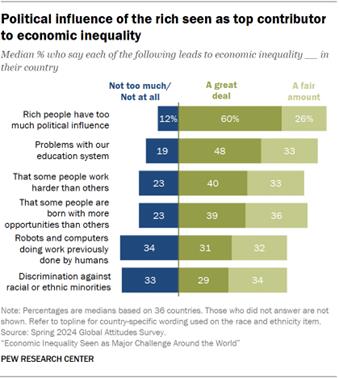
Overall, more than eight-in-ten adults say that rich people
having too much influence over politics contributes to economic inequality
either a great deal (60% at the median) or a fair amount (26%).
But respondents see other factors as important, too.
Majorities across the countries surveyed believe problems with the education
system add to inequality in their nation.
Many also attribute inequality to some people working harder
than others or some being born with more opportunities. Smaller but still
notable shares cite other factors, including robots and computers doing work
previously done by humans, and discrimination against racial or ethnic
minorities.
Economic anxiety during a
global election year
Voters in more than 60 countries went to the polls in 2024. In
many of these countries – including France, Japan, South Africa, the UK and
the U.S. – incumbents lost or suffered major electoral setbacks. Economic
concerns played a key role in these elections. For more, read our data
essay: “Global
Elections in 2024: What We Learned in a Year of Political Disruption.”
Read more: Factors seen as contributing to economic inequality
Views of other forms of
inequality
Nearly a decade and a half after the Occupy
Wall Street protests in the U.S. – which coincided with similar
movements in other countries – economic inequality remains the reality in many nations.
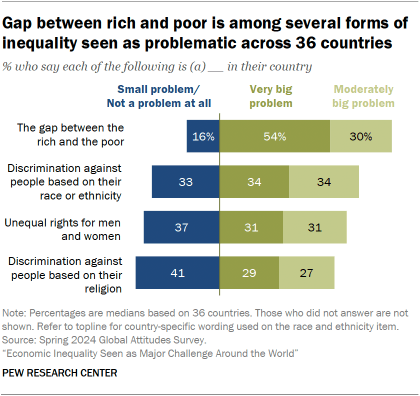
And as our survey highlights, this is a matter of strong
public concern. More than eight-in-ten adults across the surveyed countries
see the gap between rich and poor as a very or moderately big problem in
their country.
But there’s concern about other forms of inequality as well.
Roughly two-thirds say discrimination against people based on their race or
ethnicity is a very or moderately big problem where they live, while about
six-in-ten say this about gender inequality. And more than half describe
discrimination against people based on their religion as a big problem.
Concerns about these issues are often tied to respondents’
demographic characteristics, background and experiences. For example, in some
nations, people with lower incomes are especially worried about economic
inequality; racial and ethnic minorities are more concerned about racial and
ethnic discrimination; women are more concerned about gender inequality; and
people who prioritize religion are more likely to see religious
discrimination as a very big problem.
Ideological differences in
views of economic inequality
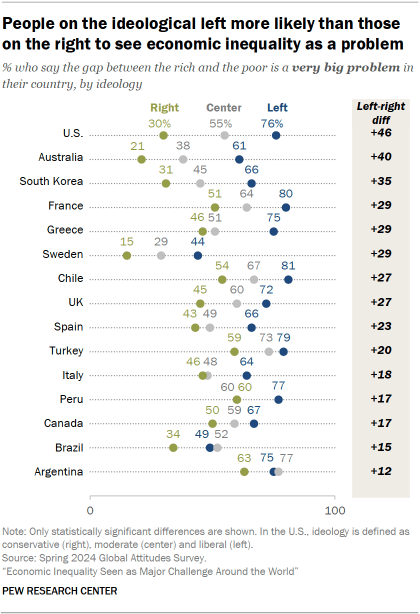
On several questions in this survey, opinions vary
significantly by political ideology.
For instance, while concerns about inequality are common
across the ideological spectrum, in many countries people who place
themselves on the left are especially likely to say the gap between rich and
poor is a very big problem.
Those on the left are also particularly likely to see racial
and ethnic discrimination and gender inequality as very big problems.
And the same pattern appears when it comes to the perceived
causes of inequality. People on the left are more likely than those on the
right to cite the political influence of the rich, racial discrimination, and
the fact that some are born with more opportunities than others.
Some of the largest ideological divisions in the survey are in
the U.S. For example, 76% of U.S. liberals say economic inequality is a very
big problem in their country, compared with just 30% of conservatives. This
46 percentage point gap is the largest left-right differences across the
countries surveyed. (The survey was
conducted prior to the November 2024 U.S. presidential election.)
Views of inequality in middle-
and high-income nations
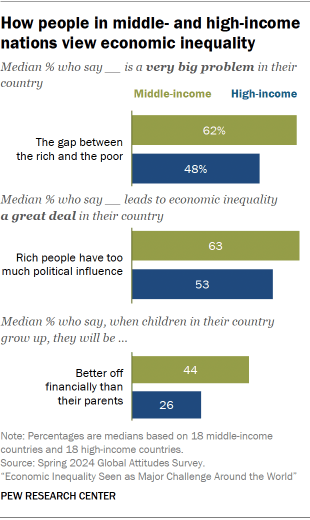
The survey finds important differences between middle- and
high-income nations in attitudes about income inequality.
(We surveyed 18 middle-income
countries and 18 high-income countries. Read Appendix A for a classification of these nations.)
While concerns about economic inequality are widespread in all
the countries surveyed, people in middle-income nations are especially likely
to describe it as a very big problem. They are also more likely to say that
the rich having too much political influence is a major cause of inequality.
But when it comes to views about the economic future, people
in middle-income nations are somewhat more positive. A median of 44% of
adults in middle-income nations believe that when children in their country
grow up, they will be financially better off than their parents. A median of
just 26% in wealthier nations expresses this view.
(PEW)
January 09, 2025
880-881-43-16/Polls
How The Gaza War Is Shaping MENA Public’s Support
For The Two-State Solution, Survey Across 8 Countries
The War in Gaza
has had dramatic effects on views of publics across the Middle East and North
Africa (MENA), as Arab Barometer findings have
revealed. Unsurprisingly, views of how the Palestinian-Israeli conflict
should be resolved have also been affected. Given the images coming out
of Gaza, it might be expected that views toward the peace process would have
hardened leading to a rise in support for radical alternatives.
However, results from Arab Barometer reveal the opposite. Not only does
support for a peaceful solution remain robust but it has also increased in
the wake of the war in Gaza.
In its recent
eighth wave of surveys, Arab Barometer included a question about the
preferred solution to the Palestinian-Israeli conflict. The question
included four options: the two-state solution based on 1967 borders; one
state for Jews and Arabs; a Palestinian-Israeli confederation; and the option
to specify a different solution. In most countries surveyed, a majority
of citizens say that their preferred solution is a two-state solution based
on 1967 borders. This includes as many as 71 percent in Mauritania, 63
percent in Tunisia, 61 percent in Jordan, 59 percent in Iraq, and 54 percent
in Kuwait. In Morocco, roughly half (48 percent) favor a two-state
solution while Lebanon is the only country where a clear minority (38
percent) hold this view.
In all
countries, support for the two-state solution remains far greater than for a
one-state solution or a confederation arrangement, which are two alternatives
that have been suggested as potential resolutions. At most, 21 percent
prefer the one-state solution in Morocco compared with at most 17 percent who
say confederation in Lebanon.
For the
remaining option, “other”, respondents were recorded in their own
words. For nearly all of these, the respondent indicated either a
military solution or a desire to see an independent Palestine that includes
the state of Israel. This option was most widely supported in Kuwait
(23 percent), Jordan (22 percent), and Lebanon (17 percent). In all
other countries, 15 percent or fewer provide a response of “other”.

While support
for the two-state solution remains the dominant preference of MENA publics,
it has also risen since Arab Barometer’s last wave of surveys in
2021-2022. In Kuwait, support for the two-state solution was 32 percent
(2022) while by April 2024 it was 54 percent. During a similar period,
gains were also observed in Jordan, rising from 51 percent to 61
percent. In Morocco, the increase was by seven points from 41 percent
to 48 percent while in Tunisia the rise was by five points and in Mauritania
by four points. In Iraq, support for the two-state solution fell
slightly from 63 percent to 59 percent while in Lebanon there was also a drop
of four points. However, in the majority of countries there is now
greater support for the two-state solution than there was before October 7.
These results
underscore that the majority of those living across the MENA countries
surveyed recognize that the only way to secure a long-term peace in the
Middle East remains the two-state solution. Despite the horrific images
from Gaza that have filled their television screens and social media feeds,
the majority do not support the destruction of the state of Israel. At
the same time, there is a steadfast commitment to the creation of an
independent Palestine. The only realistic way to achieve this goal
would be a Palestinian state coexisting next to the Jewish state, which
likely explains the rise in support for the two-state solution in the time
since October 7.
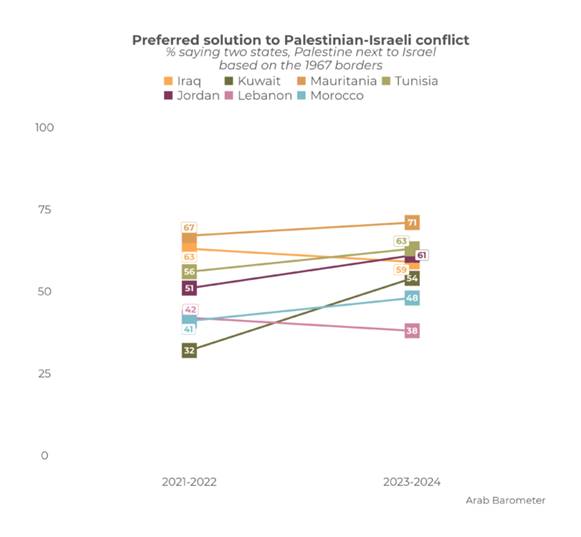
(Arabbarometer)
January 09,
2025
Source: https://www.arabbarometer.org/2025/01/support-for-the-two-state-solution-is-shifting-unexpectedly/
880-881-43-17/Polls
What Worries The World – December 2024, Study In 29
Countries
Our
monthly What Worries the World survey explores what the public thinks are the most
important social and political issues, drawing on more than ten years of data
to place the latest scores in context.
Over the past year, inflation
has been the top worry across 29 countries for 11 out of the 12 months.
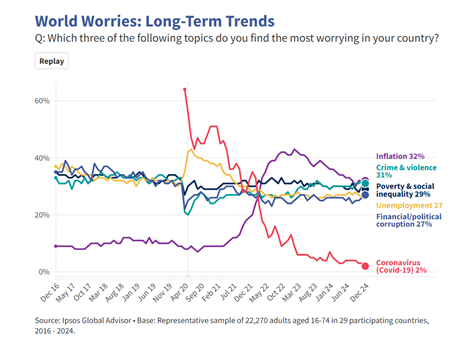
2024 key findings:
●
Inflation
in 2024:
o For eleven
months this year, cost of living was the primary issue across our 29
countries (the exception being September).
o That said,
the level of worry about the cost of living has been declining somewhat over
2024, going from 36% in January to 32% mentioning it in December.
o September
recorded the lowest level of worry for inflation at 30%, the lowest since
March 2022 (in the wake of Russia’s invasion of Ukraine, when it was 27%).
o Argentina
has experienced the largest shift in concern. Having had inflation as its top
concern for 18 consecutive months, in September Argentina’s priorities
shifted with unemployment emerging as the number one concern. Their level of
worry about inflation has dropped 30 points over the year (from 68% in
January to 38% today).
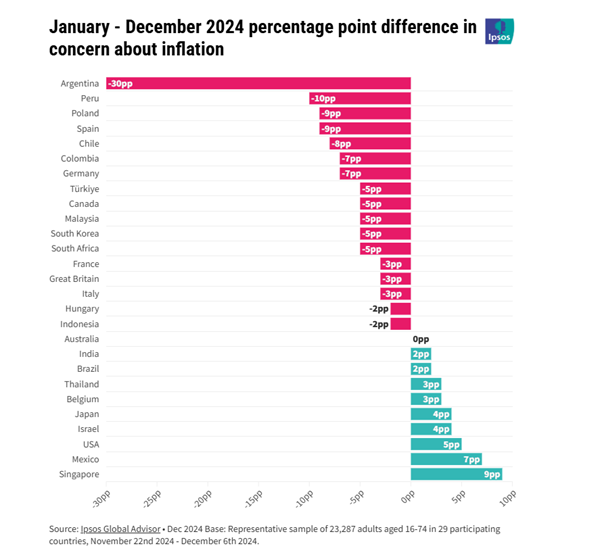
●
Right
Direction Score:
o Across 29
countries, the percentage of individuals expressing confidence that their
country is "heading in the right direction" has declined by 4pp
over the year dropping from 41% to 37%. December’s score marks the lowest
level recorded in 2024.
o Peru has
consistently been the most pessimistic country, being bottom of the list for
16 consecutive months. Currently 10% say things are going in the right
direction.
o France has
seen a big decrease this year in optimism, falling 17 percentage points, from
27% saying the nation is on the right track in January to 10% today.
o Likewise,
Poland has fallen from 57% in January to 38% (-19pp). The high score in
January could be related to October 2023’s post-election surge in optimism.
o South Africa
has experienced the biggest improvement in mood this year, going from second
last in January at 19% to 38% in December (+19pp, now 11th out of 29).
●
Crime
& violence:
o The
proportion expressing worry about crime increased slightly during 2024, going
from 29% to 31%.
o Crime &
violence broke inflation’s streak as the top global concern in September,
when 31% cited crime as one of the main issues facing their country.
o Crime
consistently ranks as a top concern for LATAM countries and Sweden. In
January, five out of six LATAM nations in our study identified crime as their
primary issue, and by December, all six listed it as their foremost worry.
●
Covid-19:
o Concern for
coronavirus across 29 countries has been tailing off. Worry has fallen from
7% in January to 2% in December (the lowest level recorded yet).
●
'Good’
economy score:
o The global
29-country average for those saying their country’s economy is ‘very good’ or
‘somewhat good’ has fallen marginally in 2024, from 38% in January to 36%.
o The G7
average has fallen further, from 32% in January to 25% in December.
o Argentina
has experienced the largest increase, of 27 points, going from 5% to 32%.
o Conversely,
France is down 20pp (30%-10%), Belgium is down 14pp (45%-31%), and Germany
and Great Britain fell 13pp (40%-27%, 35%-22%, respectively).
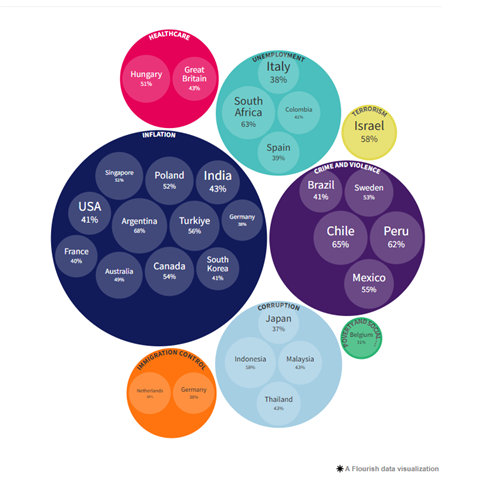
December analysis
Inflation
This December, across 29 countries, inflation remains the number one concern,
with a third (32%) expressing worry. Although still the biggest concern, it
is 5pp lower than the same time last year.
The number of countries citing cost of living as their primary
concern has risen from six to eight over the last month, with Canada and
France being the new additions, both of which have seen substantial
increases. Taking a longer-term view, in January, 11 countries identified
inflation as their top issue, including Argentina, Germany, and South Korea
The proportion of Canadians worried about prices has risen 7pp
over the month to half (49%) saying it’s a problem. Similarly, concern in
France has moved up 6pp, although not to as high a level (37%).
This time last year, Argentina’s level of concern was 32pp
higher than it is in December 2024, where we now have just shy of two-fifths
(38%) citing it.
Crime & violence
Having shared the top position last month, crime and violence has now shifted
to second place on our global concerns ranking, reflecting a moderate decline
in worry levels since November.
Last month, for Peru, inequality was their primary issue. This
month, crime & violence has become the biggest concern facing the
country, with two-thirds (65%) expressing worry. This is 7pp higher than last
December. November’s score (66%) was Peruvians’ highest score since March
2020, when it was at 71%.
Notably, the proportion mentioning crime in Türkiye has fallen
10pp to three in ten (29%). Despite the sharp fall, this level is still 11pp
higher than this time last year.
Financial/political corruption
The proportion mentioning corruption across our 29 countries has fractionally
increased this month, joint with unemployment at 27%.
In a month which has seen Benjamin Netanyahu back in court for
an ongoing corruption trial, Israel has experienced the largest increase in
mentions. Up 15pp to over a third (36%) citing it. Corruption has become more
of an issue than military conflict (35%) and is second only to terrorism
(45%). This is 6pp higher than a year ago.
Last month, Spain’s score reached a record level after the
country faced severe flooding. This month concern has reached another new
high, with a further rise of 3pp to 33%. This is 13pp higher than a year ago
and the highest it has been since March 2021 (when it was 34%).
Poverty & social inequality
The proportion mentioning poverty & social inequality across 29 countries
has marginally decreased to 29% this month.
In November, inequality was Peru’s top worry. However, after
the number of people mentioning it dropped 4pp to 29%, it is now second to
crime & violence.
In Belgium, inequality has emerged as a top concern, marking
the first time in eight months that taxes are no longer the primary issue for
the public. Mentions of inequality have risen by four percentage points, with
31% of Belgians now citing it as a major issue. This represents a
seven-percentage point increase compared to the same time last year.
Current economic situation
Looking back to January 2024, we see big changes. This time last year,
Argentina was ranked bottom, with a good economy score of just 6%. This
month, it ranks 15th of 29 countries, with a good economy score of 32%: its
highest in almost seven years (also 32% in January 2018).
But economic perceptions haven’t risen in all countries. Six
countries have recorded double digit decreases in their good economy score,
led by France (-20pp) and Belgium (-14pp) since January.
This month, a 4pp drop in Germany’s good economy score sees it
record a new all-time low (27%). Meanwhile, France (10%) has fallen into the
bottom ranked position, with its lowest score since February 2016.
(Ipsos Global)
![]()
January 07, 2025
Source: https://www.ipsos.com/en/what-worries-world
880-881-43-18/Polls
Trust In Democracy Faces
Significant Challenges, A Survey In 8 Westren Countries
Trust in democracy faces significant challenges today due to
factors such as political polarisation, misinformation and the perception of
institutional inefficiency by society. In this context, Ipsos has launched
the second wave of its “State of Democracy” study, which offers an in-depth
analysis of perceptions of the democratic system in eight Western countries,
including Spain.
The study shows that, despite a slight improvement since last
year, citizens continue to be dissatisfied with the functioning of democracy
in their country. In the case of Spain, half of the population (51%) is
dissatisfied, which places it among the least satisfied countries of those
analysed, with the same percentage as Italy, and only behind France (55%).
The functioning of democracy
has worsened over the past five years
The democratic evolution of Spanish society has laid the
foundations for a prosperous welfare system, admired throughout much of the
world. However, as in most of the countries in the study, Spaniards'
discontent with democracy has increased over the last five years. One in two
people in Spain think that the functioning of the democratic state has
deteriorated, compared to 17% who believe that it has improved.
This discontent with the system is mainly based on a lack of
trust in political leaders. The majority think that the political class
rarely keeps its promises, a perception shared by 74% of the Spanish
population. In addition, there is a widespread perception that the democratic
system mainly benefits the economic and political elites. Spain stands out as
one of the countries where this thought is most widespread, with 68% stating
this.
The Spanish population is
betting on a moderate change in the democratic system
The general dissatisfaction with the current democratic system
translates into the need for systemic changes, but the urgency of the
different societies regarding these reforms varies greatly. While Croatia,
Poland, France and Italy clearly express the desire for a radical change in
the functioning of their political system, the United States, Spain, the
Netherlands and Sweden are betting on gradual institutional reforms. The
Spanish people are divided, on the one hand, 48% of the citizens demand
drastic measures and on the other, 42% prefer moderate changes.
Voting is key to facilitating
change
In almost all the countries analysed, the majority of the
population perceives that their participation in political life is of no use,
with 40% of Spaniards stating this; however, the majority still considers
voting to be crucial to facilitating change, an idea shared by 71% of people
in Spain.
Citizens may be sceptical about the way democracy works, but
they remain active in the political and social spheres. A significant
proportion of Spain's population engages in activities such as signing
petitions (33%), boycotting products (27%) and expressing political opinions
on social media (24%), making it the country with the highest number of
people reporting doing so.
Society feels better
represented at the local level
The data from the study show that people are more satisfied
with the functioning of democracy at local or regional level than at national
or supranational level. A feeling that is confirmed in Spain, since, while
36% believe that their local government is acting well, this perception falls
to 27% for the national government, a figure shared with the work carried out
by the EU.
The European Union leads the
defence of democracy
Overall, citizens perceive the European Union and NATO as the
most effective defenders of democracy, with growing support in most
countries. Poland and Sweden, being geographically closer to Russia, have
particularly favourable views of NATO, while opinions on the Atlantic
alliance are more mixed in southern Europe, especially in Spain (21%) and
Italy (17%).
January 10, 2025
880-881-43-19/Polls
Artificial Intelligence: Key insights, data, tables
and Global Concerns in 2025"
The large language model (LLM) revolution has
brought an explosion of innovation in artificial intelligence (AI) and
related technologies — the social and cultural impact of which remain to be
seen. Ipsos is tracking the issues around data, trust, and adoption, in the
U.S. and worldwide. Read on for a high-level look at the latest data — or
visit "Gen AI: From Wow to How," the latest installment in
our Insights to Activate series.
Key takeaways:
When it comes to implementations
of AI, algorithmic bias is a frequently cited concern. Ipsos' data suggests
people are worried about the misuse of AI in various sectors — but that we trust AI not to be biased slightly more than we trust people not to be biased.
When AI-powered image generators
hit the market, millions were astonished by their creative potential.
("AI, generate me a picture of a penguin in the style of Degas.")
But Ipsos trendlines indicate that people are getting to be less enthused about
the use of AI in art, TV, and media — and that's to say nothing about how
trust varies when it comes to healthcare and other sectors.
We know that AI is already being
put to use at work, with nearly half of workers (46%) in
the United States, United Kingdom, and Australia saying they've used these
tools on the clock. But that hasn't assuaged fears about job security — particularly in labor-intensive
sectors like manufacturing.
Ipsos found that Biden's
executive order on AI received strong bipartisan support, with more than 70%
of Democrats and Republicans supporting the development of new standards for
AI safety.
Only 3% of Americans consider
themselves to be experts on AI, with 29% saying they have some knowledge. But
55% say they would be interested in learning how to use generative AI tools —
highlighting the need for education and training in this space.
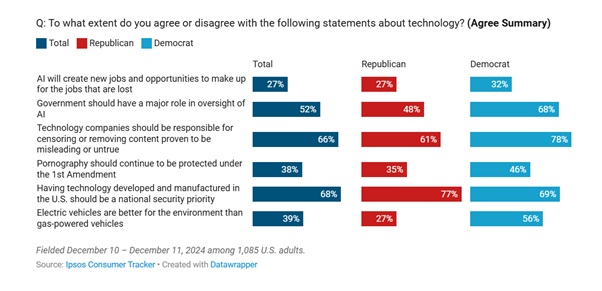
At the end of 2024, nearly half of Americans
agreed that the government should have a major role in oversight of AI.
Meanwhile, while only one in four think AI will create more jobs than it
replaces.
Fewer think AI is coming for
white collar jobs

There is a big jump in people thinking that
white collar, blue collar, and their own job prospects will get better thanks
to AI, according to the latest round of the Ipsos Consumer Tracker. And
perhaps counterintuitively, more now think AI will lead to an improvement in
energy use, despite more and more coverage of how energy-demanding it is to
run AI systems.A perceived lack of benefits is a
major barrier to adoption of AI tools
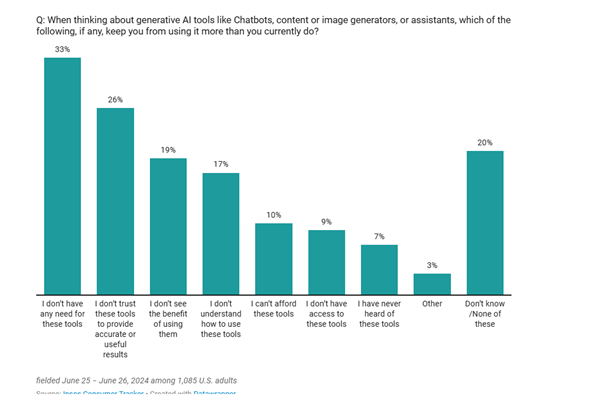 One in three people (33%) say
they don't think they have any need for AI tools, and another 19% say they
don't see the benefit of using them, according to the Ipsos Consumer Tracker.
All of this points to a marketing challenge for tech companies – though
likely a solvable one with the right creative and media.The forms of creativity people
think AI will help — and harm
One in three people (33%) say
they don't think they have any need for AI tools, and another 19% say they
don't see the benefit of using them, according to the Ipsos Consumer Tracker.
All of this points to a marketing challenge for tech companies – though
likely a solvable one with the right creative and media.The forms of creativity people
think AI will help — and harm
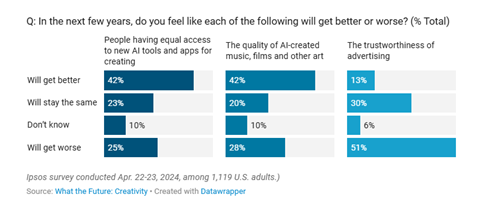
History often hints at the future. In the
past, tech disruptions led to more jobs being created than lost. There aren’t
nearly as many darkroom techs as there used to be, but there are plenty of
people creating photography. The thing here is that AI is disrupting so many
creative (and less creative) professions all at once. That’s the part that
will be hard to forecast.The AI-driven shifts Americans
find most worrying
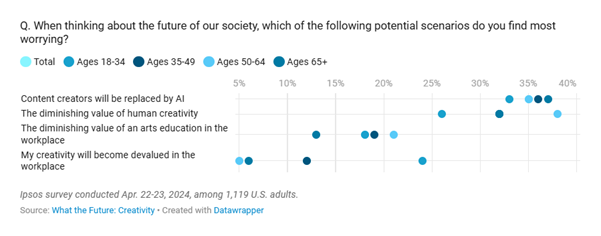
The democratization of creative tools is
revolutionizing the landscape of creativity — but also prompting new fears
around the devaluing of human ingenuity. (Read more.)
Many are growing wary of
AI-generated content
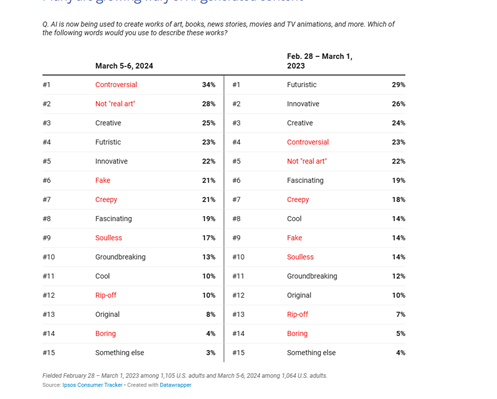
There’s been a jump in the number of
Americans who use negative words to describe AI, compared to the same time
last year, according to the Ipsos Consumer Tracker: “Fake” is up 50% to 21%;
“Cool” is down from 14% to 10%; “Futuristic” is down, as is “Innovative”;
while “Controversial” is up 23% to 34%. (Read more.)
Many are worried about the misuse
of AI…
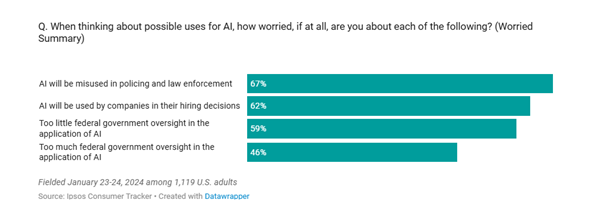
About two in three are worried AI will be
misused in policing and law enforcement, or in corporate hiring decisions.
Six in ten think there will be too little federal government oversight of AI,
while just under half (46%) think that there will be too much federal
oversight. (Read more.)
... But many trust AI more than
humans
 Only 43% of people trust AI tools
not to discriminate or show bias towards any group of people, which doesn’t
seem great — but they actually trust AI slightly more than they trust humans
(only 38%) in this regard. (Read more.)
Only 43% of people trust AI tools
not to discriminate or show bias towards any group of people, which doesn’t
seem great — but they actually trust AI slightly more than they trust humans
(only 38%) in this regard. (Read more.)
Some young adults are turning to
AI-powered mental health services
 Therapeutic uses of generative AI
remain controversial — but recent Ipsos polling suggests that one in five
young Americans has experimented with mental health services powered by this
technology. (Read more.)
Therapeutic uses of generative AI
remain controversial — but recent Ipsos polling suggests that one in five
young Americans has experimented with mental health services powered by this
technology. (Read more.)
People around the world are
worried about rampant AI
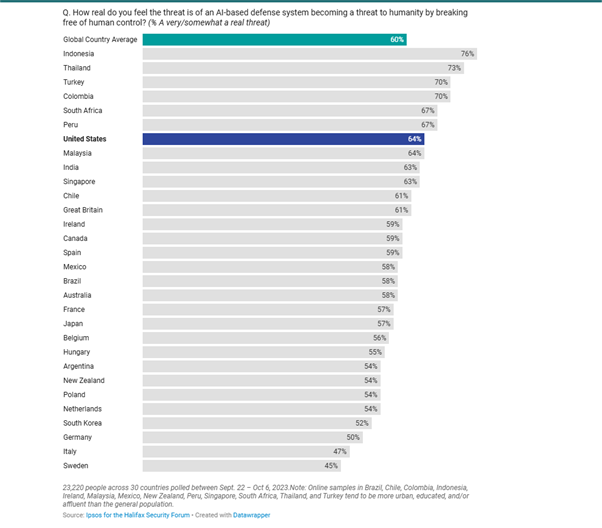
60%, on average across 30 countries, are
concerned about an AI-based defense system becoming a threat to humanity by
breaking free of human control. How real the threat is perceived to be
depends on where one lives, with 45% of people in Sweden versus 76% in
Indonesia agreeing the threat is real, while 64% of Americans think the
threat is real vs. 59% of Canadians.
(Ipsos US)
January 18, 2025
Source:https://www.ipsos.com/en-us/artificial-intelligence-key-insights-data-and-tables




